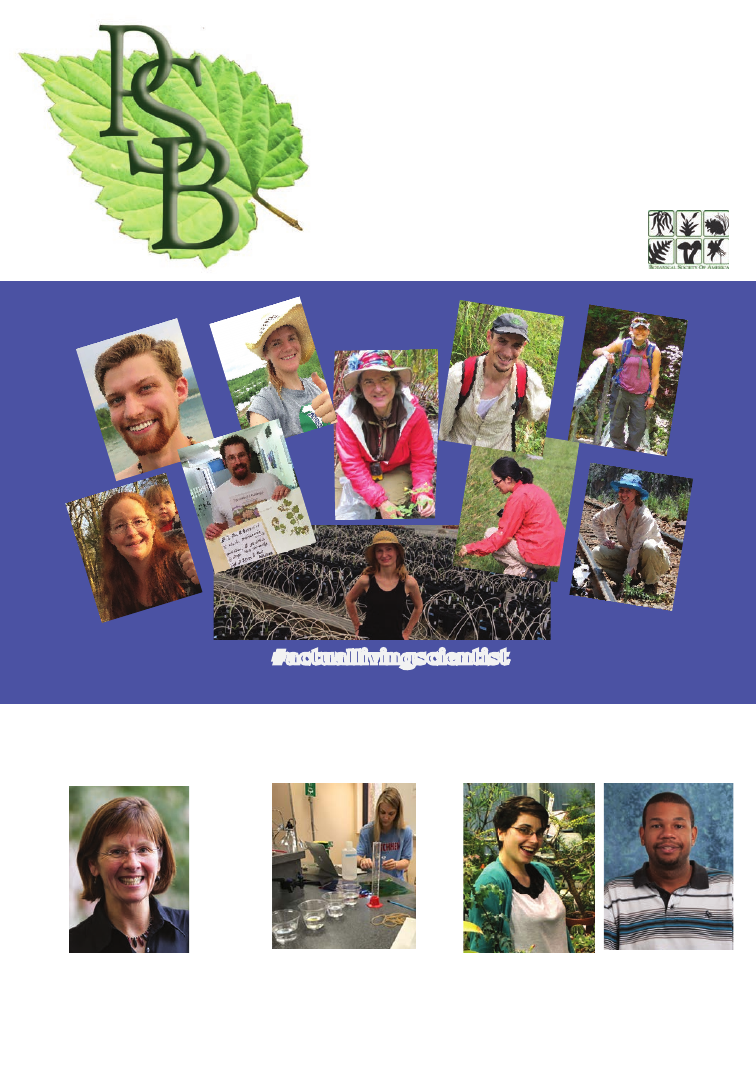
IN THIS ISSUE...
SPRING 2017 VOLUME 63 NUMBER 1
PLANT SCIENCE
BULLETIN
A PUBLICATION OF THE BOTANICAL SOCIETY OF AMERICA
Pam Diggle on Careers
Beyond the Academy...p. 17
Round-Up of Student
Opportunities........p. 23
Star Project Award Winners
in PlantingScience...p. 22
#actuallivingscientist
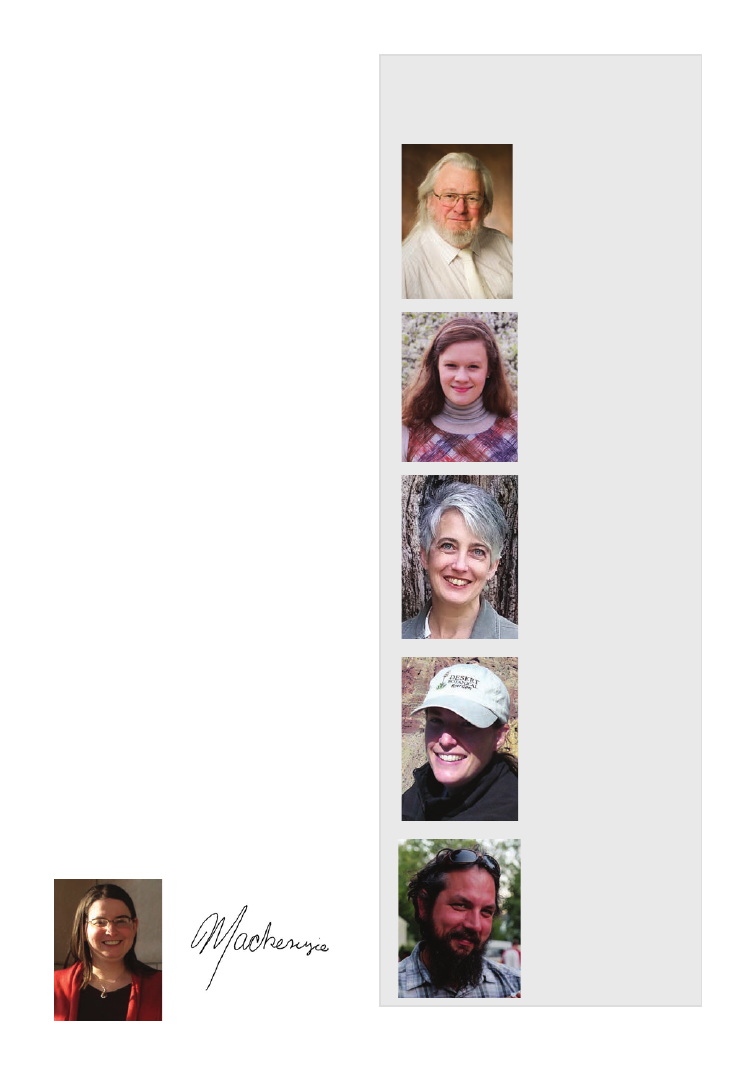
Spring 2017 Volume 63 Number 1
PLANT SCIENCE BULLETIN
Editorial Committee
Volume 63
From the Editor
Kathryn LeCroy
(2018)
Environmental Sciences
University of Virginia
Charlottesville, VA 22904
kal8d@virginia.edu
Daniel K. Gladish
(2017)
Department of Biology &
The Conservatory
Miami University
Hamilton, OH 45011
gladisdk@muohio.ed
u
Melanie Link-Perez
(2019)
Department of Botany
& Plant Pathology
Oregon State University
Corvallis, OR 97331
l
inkperm@oregonstate.edu
Shannon Fehlberg
(2020)
Research and Conservation
Desert Botanical Garden
Phoenix, AZ 85008
sfehlberg@dbg.org
Greetings!
This is the first issue of Plant Science Bulletin of
2017. This new year is already proving to be a
challenging one for many, including those of us
who work in science and education in the Unit-
ed States. Nearly every day, scientific knowl-
edge is being disputed, groundbreaking envi-
ronmental legislation is being attacked, and the
global network of scientists is being threatened.
As botanists, we have the responsibility to act
in whatever ways we can, individually and as a
group, to mitigate the actions of an administra-
tion that is blatantly anti-science.
Some action is underway. In January, the BSA
co-signed a letter with 151 other scientific en-
tities protesting the Executive Order on Immi-
gration banning travel from seven Muslim-ma-
jority countries. This letter pointed out that
scientific progress requires the flow of ideas and
people across borders. The BSA is once again
supporting the travel of two members to the
2017 Biology and Ecological Sciences Coalition
Congressional Visits Day and, in conjunction
with ASPT, supporting local efforts with the Bo-
tanical Advocacy Leadership Award. Individual
BSA members are planning to participate in the
March for Science in Washington, DC in April.
It is my hope that we, the Botanical Society of
America, will be at the forefront of this fight as
it continues, providing avenues for action and
support for other members and representing
plant science within the broader scientific com-
munity. After all, as the BSA twitter feed is fond
of reminding us, we are #notaquietscience.
David Tank
(2021)
Department of Biological
Sciences
University of Idaho
Moscow, ID 83844
dtank@uidaho.edu

1
TABLE OF CONTENTS
SOCIETY NEWS
Are you ready for Botany 2017 ................................................................................................................2
Public Policy Awards, 2017 .........................................................................................................................3
ASPT and BSA at Plant Science Research Network ..................................................................3
Public Policy Opportunities at Botany 2017 .....................................................................................4
First Annual Botany Advocacy Leadership Grant Supports Outreach in Oklahoma .4
Convergent Evolution of National Science Education Projects:
How BSA Can Influence Reform (Part 2) ............................................................................................6
The
American Journal of Botany welcomes your collaboration in 2017 .....................14
Why publish your next methods paper in
Applications in Plant Sciences? .................15
SPECIAL FEATURE
Careers Beyond the Academy ...............................................................................................................17
SCIENCE EDUCATION
Over 2000 Students Conduct Plant Science Investigations This Fall Through
PlantingScience.org ......................................................................................................................................21
Visit BRIT during Botany 2017 for a Tour or Workshop ..................................................................................................21
Life Discovery Conference—Data: Discover, Investigate, Inform ..........................................22
STUDENT SECTION
Round-up of Student Opportunities ....................................................................................................23
ANNOUNCEMENTS
Eagle Hill Institute Natural History Science 2017 Field Seminars ....................................31
Pam and Doug Soltis Awarded the 2016 Darwin-Wallace Medal .....................................31
In Memoriam
Thomas Norwood Taylor (1938—2016) ..................................................................................33
Hugh Iltis (1925–2016) .....................................................................................................................36
BOOK REVIEWS
Conservation ....................................................................................................................................................39
Ecology ................................................................................................................................................................41
Economic Botany ...........................................................................................................................................43
Education ............................................................................................................................................................48
History .................................................................................................................................................................49
Systematics ......................................................................................................................................................51
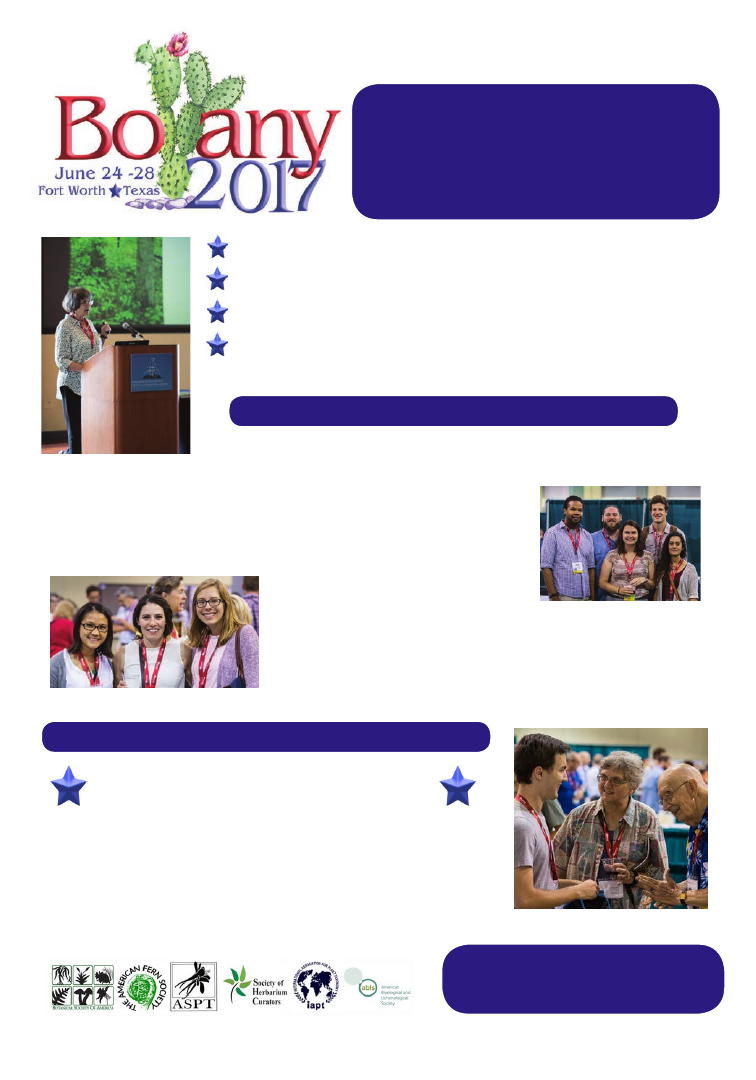
PSB 63 (1) 2017
2
Dr. Ranessa Cooper started coming to BOTANY conferences
as an undergrad 20 years ago. "This is my meeting,” she
stresses. "There is no better meeting to adopt. I love to come
because of the great people and the breadth of science."
Are you ready for Botany 2017?
Fort Worth, Texas
June 24 -28
Plenary Lecturer - Robin Kimmerer
Emerging Leader Special Lecture - Michael Barker
Annals of Botany Special Lecture - Anna Traveset
Regional Botany Special Lecture - Barney Lipscomb
and Jason Singhurst
What can you expect from BOTANY 2017?
It is one of the friendliest places to present your research, make
connections, and find collaborators.
“The size of the Botany Conferences is perfect, not too big or
too small,” says Dr. David Gorchov. “And, I am exposed to the
cutting edge research outside my discipline of ecology.”
Register now
www.botanyconference.org
You are going to love our location!
Sundance Square and Downtown Fort Worth
have so much to offer!
Other than great places to eat and drink, from cheap to fancy,
be sure to devote a few hours to walking around and visiting
the shops, the Sid Richardson Art Museum, Bass Hall,
the Water Gardens, and more.
Molly the Trolley runs through downtown Fort Worth 7 days a
week from 10am -10pm. Best of all—it’s free!
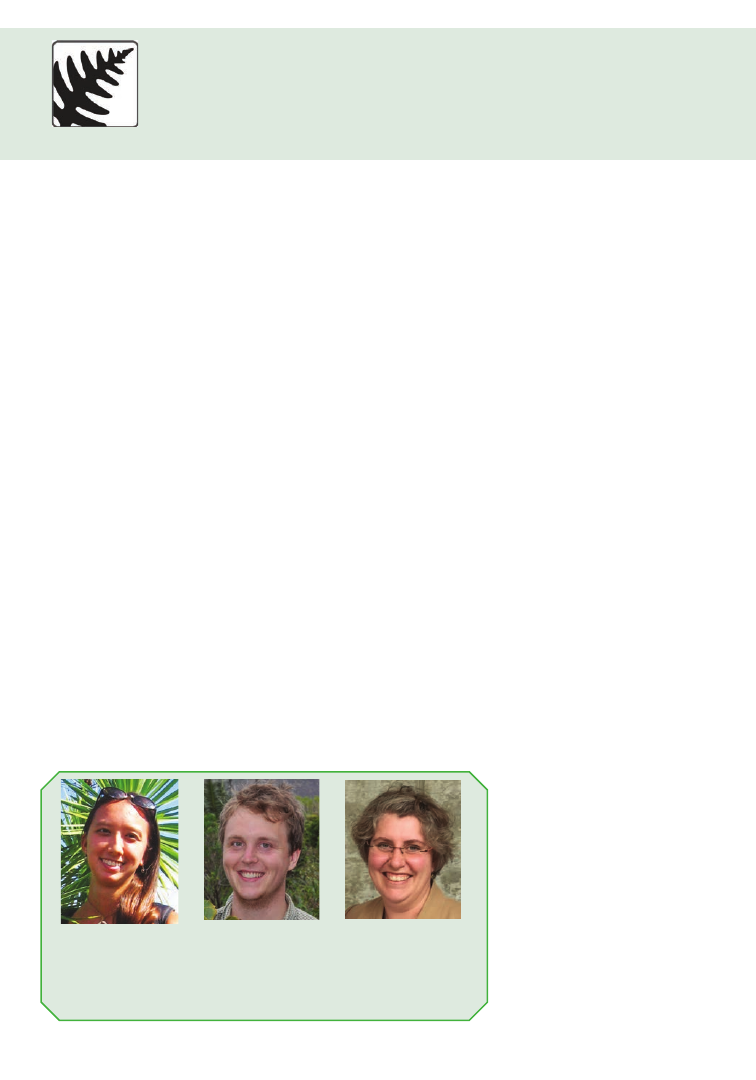
3
SOCIETY NEWS
By Marian Chau (Lyon Arboretum University of Hawai‘i at Mā-
noa) and Morgan Gostel (Smithsonian Institution), Public Policy
Committee Co-Chairs, along with Ingrid Jordon-Thaden (Uni-
versity of California Berkeley), ASPT EPPC Chair
Public Policy Awards, 2017
Congratulations to Andre Naranjo and Mari-
beth Latvis, Ph.D., recipients of the 2017 BSA
Public Policy Award, and Christopher Tyrell,
recipient of the ASPT Congressional Visits
Day Award! Andre, Maribeth, and Christo-
pher will be traveling to Washington, DC to
participate in the 2017 Biological and Ecolog-
ical Sciences Coalition Congressional Visits
Day (25–26 April 2017). Look for a write-up
of their experiences in the next issue of the
Plant Science Bulletin!
ASPT and BSA at Plant
Science Research Network
The Steering Committee of the Plant Science
Research Network (PSRN) met February
9-10, 2017, in Tucson, AZ to discuss the cur-
rent draft of the National Plant Systems Initia-
tive (NPSI) and review progress on strategic
planning for Plant Science, particularly in the
areas of Training, Cyber-infrastructure, and
Broadening Participation. The NPSI docu-
ment was created by the PSRN, which is an
NSF-supported Research Coordination Net-
work ultimately consisting of 15 professional
societies given the task to collectively imag-
ine the future of plant sciences and its role in
agriculture, biodiversity, and ecosystem and
food security into the future. This effort has
been in progress since 2011 with the publi-
cation of the Decadal Vision (http://bti.cor-
nell.edu/our-research/enabling-technologies/
decadal-vision/) and the establishment of
the Plantae community (http://www.plantae.
org/), and now is culminating in the develop-
ment of the NPSI to help direct policy, edu-
cation, and training decisions for establishing
funding and developing research planning
and collaboration across the plant sciences.
Our representatives who attended this Feb-
ruary meeting from BSA and ASPT—Alli-
son Miller and Chelsea Specht, respective-
ly—along with BSA’s official representative,
Michael Donoghue, will help our societies’
interests be represented in the planning and
keep us informed on upcoming federal ini-
tiatives or opportunities for research, train-
ing, and broadening partici-
pation. Ecological Society of
America (ESA) representative
Evan DeLucia was also in at-
tendance, representing addi-
tional support for the fields
of plant research supported
by BSA and ASPT. Be on the
lookout for more informa-
tion!

PSB 63 (1) 2017
4
Public Policy Opportunities at Botany 2017
Want to know how to be more involved in public policy communication for science? Sign up
for the AIBS Communicating Science to Decision-makers workshop at Botany 2017, held on
June 25 from 9:00 AM to 12:00 PM. This three-hour workshop will be presented by Dr. Robert
Gropp, AIBS Interim Co-Executive Director. Space is limited to 30 participants and will fill up
soon!
If you have any questions, please don’t hesitate to contact the ASPT Environmental and Public
Policy Committee or the BSA Public Policy Committee. More details are in the call for appli-
cations.
Michael Dunn sent the following thank-you
note to the ASPT Environment and Public Pol-
icy Committee and BSA Public Policy Com-
mittee regarding the Annual Botany Advocacy
Leadership Grant that Dunn and the Oklaho-
ma Native Plant Society received.
Thank you for your support of botanical
public outreach by your generous award of
$1000 as an Annual Botany Advocacy Leader-
ship Grant, through me, to the Southwestern
Chapter of the Oklahoma Native Plant Society.
The goal of this grant is to bring together as
many of the institutions and organizations in
southwestern Oklahoma who are at least in
part like-minded in that they attempt to use
plants to enhance the quality of life of the re-
gion. And to use plants as they relate to nat-
ural history, anthropology and archeology,
horticulture and agriculture, as well as plants
as an excuse to simply get outside.
We are well on our way to achieving many
of our goals with our partners including
The Oklahoma Native Plant Society, Wich-
ita Mountains Wildlife Refuge, Friends of
the Wichita’s, Fit Kids of SW Oklahoma, The
Medicine Park Aquarium and Science Center,
Cameron University, Oklahoma State Univer-
sity Extension Service, The Museum of the
Great Plains, and the Greater Southwest Okla-
homa Anthropological Society.
Our first sponsored event was 27 August 2016
at The Museum of the Great Plains, and was
co-sponsored by the Greater Southwest Okla-
homa Anthropological Society. Bob Blasing, a
retired anthropologist with the Bureau of Rec-
lamation spoke on “How Early Great Plains
Tribes used Seasonal Travel to Obtain Re-
sources”. More than 30 people attended (Fig-
ure 1), including some unexpected, but most
welcome guests. The Secretary of Agriculture
for the Comanche Nation attended, and he
and I were able to discuss historical plant use
by the Comanche Tribe. This is particularly
exciting as the tribes here in “The Nations”
(a.k.a. Oklahoma) have been very protective
of their ethnobotanical heritage, and this was
an incredible breakthrough. Our collabora-
tion continues.
On 8 October 2016, we sponsored the Annual
Meeting of The Oklahoma Native Plant Soci-
ety. We met that morning at The Environmen-
tal Education Center of the Wichita Moun-
tains Wildlife Refuge (WMWR) and several
field trips were available including Aquatiic
Plants of the WMWR, and a discussion/walk
First Annual Botany Advocacy Leadership Grant Supports
Outreach in Oklahoma

PSB 63 (1) 2017
5
To future recipients of
this [Botany Advocacy
Leadership Grant], I
cannot express how
rewarding it is to work
with these grassroots
organizations. But
they are grassroots
volunteer organizations
that require patience
and understanding, but
believe me, that patience
will be rewarded as you
will be working with
some truly dedicated
and enthusiastic amateur
botanists and other types
of plant people.
Figure 1. Bob Blasing speaking to a mixed
crowd at the Museum of the Great Plains. The
Secretary of Agriculture for the Comanche Na-
tion is in the fourth row, far right in a red shirt,
hidden except for his cowboy hat.
about designing and constructing self-guided
plant tours. Lunch was provided by the Friends
of the Wichitas, and Susan Howell, the Visitor
Services Coordinator for WMWR, spoke af-
ter lunch on “Maintaining the Health of the
Mixed Grass Prairie.” The Keynote Speaker
that evening was David Redhage from the
Kerr Center for Sustainable Agriculture, who
spoke on “Pollinators and Native Plants.”
In April or May of 2017, we will join with The
Medicine Park Aquarium and Science Center,
Fit Kids of SW Oklahoma, and Lawton Public
Schools to bring eighth graders to The Medi-
cine Park Aquarium and Science Center for a
native plant and pollinators workshop. These
details are still being worked out.
To date most of the funds provided by the
grant have been used to pay travel expenses
for our speakers, but we hope to have enough
money left to pay for the busses to bring the
eighth graders to our workshop.
Thank you to the American Society of Plant
Taxonomists and The Botanical Society of
America for this Botany Advocacy Leader-
ship Grant. I hope we have used, and are us-
ing your funds as you had hoped. To future r
ecipients of this grant, I cannot express how
rewarding it is to work with these grassroots
organizations. But they are grassroots volun-
teer organizations that require patience and
understanding, but believe me, that patience
will be rewarded as you will be working with
some truly dedicated and enthusiastic ama-
teur botanists and other types of plant people.
-By Michael T. Dunn, PhD, Professor, Depart-
ment of Agriculture and Biological Sciences, Cam-
eron University, Lawton, Oklahoma 73505
USA

PSB 63 (1) 2017
6
The first part of Dr. Uno’s speech, taken from his
address at the Botany 2016 conference, can be
found at http://botany.org/file.php?file=Si-
teAssets/publications/psb/issues/PSB-2016-62-
3.pdf.
Convergence of National
Science Education Projects
There are multiple signs that the scientific
community in academia has accepted science
education as a legitimate activity in which
colleagues can engage. In Part 1 of my talk, I
identified seven signs that indicate to me that
we have reached the tipping point in science
education. The eighth, and last, indicator is
the fact that several national science educa-
tion reform projects have converged on sim-
Convergent Evolution of National
Science Education Projects: How
BSA Can Influence Reform (Part 2)
Remarks from Botany 2016 by President-Elect
Gordon E. Uno
By Gordon E. Uno,
BSA President-Elect
University of Oklahoma
ilar messages to the biology community. The
Next Generation Science Standards (NGSS)
from the NRC (2013), Vision and Change
from AAAS (2011), the AAC&U’s LEAP Ini-
tiative and High Impact Practices (2011), and
the College Board’s revision of the Advanced
Placement (AP) Biology course in 2012 are
just four of these large-scale projects that have
and will continue to have great impact on sci-
ence education in the United States.
How are these projects converging? I think
there are five major ways these major projects
are similar in their explicit and implicit rec-
ommendations to the science community:
1. Student outcomes or competencies should
be used to organize a course or program—
competencies are those characteristics that
we desire students to possess at the end of in-
struction and are measures of student learn-
ing about subject knowledge and ability to
use important skills. What is different from
previous reports is that competencies help us
determine how students should learn science
practice skills while they are learning con-
tent; neither content nor skills are taught in
isolation. For instance, there should not be a
50-minute lecture on photosynthesis without
students working with data or graphs or de-
signing experiments related to the subject. In

PSB 63 (1) 2017
7
addition, we need to help students think about
their own learning—what do they understand
and what are they still confused about?
2. These national science education projects
emphasize that the investigative process
of science, including critical thinking and
inquiry skills and student investigations,
should be the cornerstone of all science
courses. Critical thinking and inquiry skills
(Box 1) have often been limited to laborato-
ry settings, but we know that they should be
practiced throughout a course. In terms of
research, students should be able to conduct
authentic research to the extent possible and
be exposed to science as a process as soon and
often as possible. Thus, faculty need to find
ways to allow students to practice the skills
shown in Box 1 every day—while not all of
them can be used on the same day, students
should be engaged in at least one of them ev-
ery day.
3. Faculty should focus on student learn-
ing and understanding instead of worrying
about what to teach, i.e., become more “stu-
dent-centered.” This happens when a facul-
ty member is more concerned about helping
students understand whatever information is
taught instead of just being worried about what
to teach.
4. To do all of the above, faculty are urged
to use “evidence-based” activities (Box 2),
those teaching methods that science edu-
cation literature indicates are effective in
helping students learn science. As one might
expect, these activities are infused with inqui-
ry and critical thinking skills, and faculty are
encouraged to use these activities every day in
both lecture and lab. The important issue here
is that, although we have a good idea of what
works in the classroom and although most
faculty have heard about some evidence-based
activities, few faculty have the knowledge or
Box 1. A List of Critical-Thinking
and Inquiry Skills
1. Make careful observations and ask
good questions.
2. Develop appropriate hypotheses and
explain predictions.
3. Design a controlled experiment.
4. Collect, process, and interpret data
(quantitative skills).
5. Discuss ideas and draw conclusions.
6. Infer and generalize.
7. Distinguish between cause and effect
vs. correlation.
8. Recognize assumptions and biases.
9. State, evaluate, and justify claims us-
ing evidence.
10. Communicate science effectively
(explain concepts in your own words).
11. Apply knowledge to new situations;
make connections between concepts.
experience to implement these activities ef-
fectively. This raises the importance of faculty
professional development to inform facul-
ty of these methods and to let them practice
and think about how these practices would be
used intentionally in their classrooms.
5. National science education projects have
also converged on their position regarding
the teaching of science content; while con-
tent is essential, less is definitely more, and it
is equally important for students to be able to
apply the content they have learned to new
situations and to connect ideas, facts, and
concepts to each other. Additionally, there

PSB 63 (1) 2017
8
Box 2. What Works: A List of Teach-
ing/Learning Methods Demonstrated to
Be Effective in Helping
Students Learn Science
1. Authentic Student Research
2. Experience Science as a Process Through-
out Course
3. Metacognitive Activities
4. Drawing to Explain
5. Writing for Understanding
6. Explaining Concepts in Their Own
Words
7. Creating Summaries of Content and Re-
search
8. Peer Instruction
9. Communicate Science and Discuss Con-
cepts/Problems
10. Problem Solving (problem-based learning)
11. Making Connections
12. Concept Mapping
13. Applying Knowledge to New Situations
14. Creating a Scientific Explanation Using
Evidence
15. Focusing on Basics First
16. Using Themes to Organize Content
17. Clicker Questions (some)
18. Critical-Thinking Skill Activities
19. Formative Assessments (concept inven-
tories)
20. Case Studies
21. Dealing with Misconceptions
22. Constructivist Lessons (scaffolding
knowledge and skills)
23. Getting Students to Ask Questions and
Make Careful Observations
24. Focusing on How We Know
25. Using Stories to Learn about Science
is the recommendation to use themes in the
teaching of biology courses, themes such as
evolution or biological interactions, so that
whatever content is taught, students are able
to connect that information to a theme. This
allows students to form a framework for their
understanding of all biology. Finally, several
reports recommend that attention be paid to
the interdisciplinary nature of biology.
While the major science reform projects were
developed mostly in isolation from each oth-
er, they were informed by the same science
education literature; thus it is not too sur-
prising that there was convergence on some
of the central tenets for change. For instance,
the NGSS recommends that science education
should reflect real world interconnections (as
noted in #5 above); concepts should be inte-
grated with multiple core concepts throughout
(the use of themes); science concepts should
build coherently (scaffolding of skills and con-
tent); focus should be on application of con-
tent (applying knowledge to new situations);
and science education should coordinate with
mathematics standards (quantitative reason-
ing). Vision and Change from AAAS recom-
mended that courses “integrate core concepts
(themes) throughout the curriculum,” and
“integrate scientific process skills throughout
the course,” and that “fewer concepts should
be taught, but in greater depth.” Vision and
Change also recommended that the course be
inquiry-driven and introduce research experi-
ences as an integral component in the course.
As with other documents, Vision and Change
identified desirable student competencies,
including the abilities to: (1) apply the pro-
cess of science, (2) use quantitative reason-
ing, (3) use modeling and simulations, and
(4) tap into the interdisciplinary nature of
science. The AACU’s Liberal Education and
America’s Promise (LEAP) project identified
essential learning outcomes for students, such

PSB 63 (1) 2017
9
Announcements
as their ability to: (1) focus on Big Questions
(problem-solving) in society, (2) focus on in-
tellectual and practical skills, (3) practice pro-
gressively more challenging problem-solving
(scaffolding of skills), and (4) demonstrate
application of knowledge, skills, and respon-
sibilities to new settings and complex prob-
lems. In addition, included in the AACU’s
High-Impact Practices (HIPs) recommenda-
tions is the focus on undergraduate research
throughout the undergraduate program, cul-
minating in a capstone course or project that
requires a student to synthesize all that he/
she has learned and is able to do. Successful
participation in HIPs has been found to: (1)
increase the retention and graduation rates of
students, especially for historically disadvan-
taged students, (2) generate more positive stu-
dent attitudes about college, faculty, learning,
and themselves, and (3) increase self-reported
students gains in learning (Kuh, 2008). As a
HIPs Institute Faculty Mentor for the past four
years, I can attest to many changes institutions
around the country have seen in students after
they implement HIPs into their undergradu-
ate degree programs.
The last major project I would like to discuss is
the revision of the College Board’s Advanced
Placement (AP) science courses. These
courses are taught in high schools around
the country, but are designed to be similar to
a freshman-level undergraduate class. I was
the co-Chair of the AP Biology Development
Committee for the last eight years; this com-
mittee helped revise the AP Biology course,
to create a curriculum framework used by all
the AP Biology teachers (~12,000 teachers),
and to develop the new Biology exams. The
problem with the former AP Biology course
was that it was content-driven, and students
and teachers tried, unsuccessfully, to “cover”
an entire college biology text in complete de-
tail. The new course emphasizes a reduced
breadth of content and an increased depth of
student understanding while increasing the
use of essential reasoning and inquiry skills.
Also, there is now a major focus on “science
as a process” in the course, and content is
melded with science practice skills to create
student learning outcomes. The new AP Bi-
ology curriculum framework focuses on four
“Big Ideas” (themes) that inform the content
of the course: (1) evolution, (2) energy and
homeostasis, (3) information transfer, and
(4) interactions among organisms, systems,
and their parts. The seven Science Practices
(Box 3) have been adopted by all the new sci-
ence courses that AP offers, including biology,
chemistry, and physics, and serve as the foun-
dation for all the skills that students need to
possess.
The new AP Biology course emphasizes inqui-
ry-based and student-directed labs. Where-
as the old course had many teacher-directed
labs, in the new course, students generate
their own questions for investigation, and
design, conduct, and report on their own ex-
periments. Not only has the course changed
dramatically, the exam has too. No longer are
any low cognitive level, declarative knowl-
edge, recall questions asked, such as “What is
the name for this structure in the cell (with a
picture pointing to a chloroplast)?” Now, stu-
dents must engage with evidence—either with
evidence they produce by working with data
or with evidence that is provided to them—to
answer a question that incorporates both bi-
ological content and one of the seven science
practice skills. In addition, students are giv-
en six new “grid-in” questions, which require
students to work with data and then to pro-
vide numerical answers that they grid into a
template, without the benefit of any answers
from which to choose. The final new piece of
the exam are six short essay questions in addi-
tion to two of the familiar long essay questions

PSB 63 (1) 2017
10
Box 3. Science Practices Adopted by
and Incorporated into Advanced Place-
ment (AP) Biology, Chemistry, and
Physics Courses
1. Use representations and models to com-
municate scientific phenomena and solve
scientific problems.
2. Use mathematics appropriately.
3. Engage in scientific questioning to ex-
tend thinking or to guide investigations.
4. Plan and implement data collection
strategies in relation to a particular scien-
tific question.
5. Perform data analysis and evaluation of
evidence.
6. Work with scientific explanations and
theories.
7. Connect and relate knowledge across
various scales, concepts, representations,
and domains.
that students must answer in the second half
of the exam.
The immediate impact of the new AP Biolo-
gy course was that 12,000 high school teach-
ers changed the way they taught biology at
the same time, and each May, approximately
250,000 students take the new exam. Many
teachers had to replace all their laboratory in-
vestigations or incorporate many more labs
into their course. They all needed to incor-
porate inquiry and mathematical activities
throughout their course, not just in a few
labs. On one of the old AP biology exams,
about 11% of the questions related to evolu-
tion, but because evolution is a theme of the
new course, approximately 35% of the ques-
tions on one new exam involved evolution.
In 2012, before the revision, about 19% of all
students received a “5” on the exam (highest
score), while 34.8% received a 1, and only 14%
received a 3. After the revision, about 5% of
students received a “5,” 7% received a “1,” and
“36% received a “3.” Thus, the old exam had
a bi-modal distribution of scores (with many
1s and 5s), which was an exam that rewarded
those who could memorize a lot of material,
even if they didn’t understand the material or
couldn’t design an experiment. The results
of the new exam show a normal distribution
of students with many fewer 5s and 1s and
many more students receiving an “average”
(3) score. To me, this indicates that we are no
longer just rewarding (or penalizing) students
based on their memory of a lot of biological
facts, but that AP Biology is now measuring
students’ ability to design experiments and to
apply, connect, explain, and use information
and data.
How BSA Can Influence
Educational Reform
Based on the information I have provided at
the beginning of this article and in Part 1, I
think there is growing acceptance of science
education as a research discipline. And, we
know what works in a classroom to help stu-
dents learn science and stay committed to
biology as a major. Finally, we know there is
continued relevance of plants in future basic
and applied research. So, it’s incumbent upon
us to integrate these factors as we work toward
solution to our educational problems. The
question is, “How can BSA help to influence
science education reform?” I have several rec-
ommendations.
First, we botanists need to keep educating stu-
dents, the public, and other scientists about

PSB 63 (1) 2017
11
the essential nature of plants to humans and
to the future research initiatives in the United
States. Also, if one of our goals is to get more
undergraduates interested in plant biology as
a viable career choice, then introducing more
students at the freshmen level to the wonders
of botany is important. We must encourage
the best botanical instructors to teach large,
basic courses, and support them when they do,
so that young undergraduates can be hooked
on botany before they choose a different path.
There are over 2,000,000 freshmen entering
U.S. colleges and universities each year (U.S.
Bureau of Labor statistics, 2016), and most of
these students are going to take an introducto-
ry biology course. If we can infuse more bot-
any into these courses, then we have a better
chance of having students take future botany
courses. Currently, over half of the students
take their introductory biology course at a
community college. So, if you have finishing
graduate students who are looking to enter the
teaching profession, then don’t neglect the op-
portunities at a 2-year institution. (At the 2016
annual conference, we invited faculty from re-
gional community colleges near Savannah to
attend a workshop on inquiry instruction that
was led by Marsh Sundberg, Catrina Adams,
and myself.) Another point about commu-
nity colleges is that their student populations
are extremely diverse, and if we value a BSA
with membership that reflects the diversity of
America, then we need to cultivate students
who begin their educations at these regional
institutions. (In terms of diversity, the BSA
has a wonderful program, PLANTS, that is
funded by NSF [A. Sakai and A. Monfils, PIs,
with BSA Staff, H. Cacanindin] and that has
been bringing a diverse group of undergradu-
ates to our annual meeting since 2010 [http://
botany.org/awards_grants/detail/PLANTS.
php]).
The higher education system in the United
States is unique in the world in that almost all
post-secondary institutions require students
Although we have a good
idea of what works in the
classroom and although
most faculty have heard
about some evidence-
based activities, few
faculty have the
knowledge or experience
to implement these
activities effectively. This
raises the importance
of faculty professional
development to inform
faculty of these methods
and to let them practice
and think about how
these practices would be
used intentionally in their
classrooms.
to take general education courses, including
at least a year of science, with one lab course.
Scientists often lament that this requirement
is really insufficient for any college graduate
entering a world that is impacted by science
and technology. However, one can also see
this as a half-full glass and a huge opportunity
to influence young undergraduates by placing
the best botanical instructors in general edu-
cation courses. For many students, including
future politicians, journalists, citizens, voters,
and some teachers, this may be the only bi-
ology course they ever take. In general, BSA

PSB 63 (1) 2017
12
should help botanists obtain faculty positions
in biology departments. Perhaps we can of-
fer mock job interviews and continue our re-
sumé-building workshops to help our grad-
uates gain faculty positions where they can
have influence on students and curricula.
We must encourage
the best botanical
instructors to teach
large, basic courses,
and support them when
they do, so that young
undergraduates can be
hooked on botany before
they choose a different
path.
Another important way that BSA can influ-
ence reform is if members improve our own
botany/plant biology courses, implementing
what we know works to help students learn
and focusing on competencies identified as
critical for student success. To help facul-
ty improve, BSA can offer additional faculty
professional development opportunities—not
just at BSA conferences, but at other meet-
ings and at individual institutions. Again, we
know that some BSA members are already
leading professional development activities
for faculty and graduate students—perhaps
we can advertise activities you are leading to
promote your work and provide greater ac-
cess to them. In terms of professional devel-
opment, one of the newest Research Coordi-
nation Networks for Undergraduate Biology
Education (RCN-UBE) projects is the Facul-
ty Developers Network (Deborah Allen, PI;
Uno, co-PI), and one part of this project is to
determine what scientific societies are doing
to help their members do a better job in the
classroom. BSA can contribute a lot to this
discussion.
One hidden aspect of getting more botanists
into introductory classes is the fact that AP
Biology conducts a “higher-ed validation”
study to determine what topics/concepts
should be included in the course. A list of po-
tential topics is sent to undergraduate faculty
who teach Introductory Biology courses, and
if insufficient numbers of them identify plant
topics as relevant to their course, these topics
will be eliminated from consideration for the
AP Biology curriculum. This kind of unex-
pected consequence of having botanists in the
right place at the right time can have a signif-
icant impact on what is taught in classrooms
all across the country. Consider working with
national educational testing services such as
the Educational Testing Service (ETS) to help
develop questions for the AP and SAT exams.
Getting more botanical questions on these ex-
ams means that pre-college teachers will de-
vote more time teaching about plants.
I think that BSA also needs to think about
ways to increase our outreach to the general
public. Perhaps we can cultivate secondary
members—for instance, amateur botanists or
other non-botanical professionals who are in-
terested in plants, the environment, and per-
haps even in basic plant research to become
members or attend our conferences? Can
we encourage more BSA members to offer
demonstrations and talks, and to lead field
trips for environmental groups, Native Plant
societies, gardeners, youth groups, and groups
such as the Botanical Society of Washington
(a long-standing forum for all things botani-
cal)? I know that many BSA members are al-
ready engaged in a number of such outreach
activities—perhaps we just need better adver-
tisement of these events so other members
can learn about what you are doing and to use

PSB 63 (1) 2017
13
your activity as a model.
I think that BSA must continue to collaborate
with other scientific organizations to promote
scientific and botanical literacy of our students
and the general public. BSA and the Ameri-
can Society of Plant Biologists (ASPB) have
collaborated on the development of “Core
Concepts and Learning Objectives in Plant
Biology for Undergraduates”
(http://
botany.org/file.php?file=SiteAssets/outreach/
botany-pbiologycoreconcepts.pdf).
In addi-
tion, we are currently working with the ASPB
and other plant societies in the Plant Science
Research Network, a network funded through
an NSF grant from the RCN program. The
purpose of the network is to discuss common
issues that all plant biologists may experience
as professionals, including issues related to
funding, publishing, graduate students, and
education.
We have a very good Education Department
whose work was recently rewarded with an
NSF grant to continue ramping up Planting-
Science activities. We must continue to sup-
port the work of the Education Department;
perhaps you would be interested in signing
up as a PlantingScience mentor? This depart-
ment has several other projects that have been
initiated or are being discussed, but this is an
area where more BSA members can become
engaged and more activities and projects can
be developed. Do you have any ideas or rec-
ommendations for the Education Department
and BSA?
I also think we need to engage more under-
grads in activities in our own departments
and to bring more students to our meetings so
they get hooked on plants and BSA at an early
point in their career. We can encourage and
engage students who are interested in bota-
ny by starting a BSA Student Chapter at our
own institution. Currently, there are only 19
such chapters in the United States. Informa-
tion about how these can be started is found
at: http://botany.org/students_corner/
chapters/.
Most importantly, I encourage each of you
to seek opportunities in which you can in-
crease your impact on students and col-
leagues, whether it is in your own classroom
or through projects at the national level or in
communicating science to the general pub-
lic. I urge you to think about how you can
promote plants and educational reform and
improve the botanical literacy for all, and I
would gladly accept suggestions from you for
how BSA can continue to have an impact on
students, botanical friends, and faculty col-
leagues. Thank you very much.
Literature Cited
American Association of Colleges and Universi-
ties. 2011. The LEAP Vision for Learning:
Outcomes, Practices, Impact and Employers’
Views. Washington, D.C.: AACU. 29 pp.
Brewer, C. A. and D. Smith, eds. 2011. Vision and
Change in Undergraduate Biology Education: A
Call to Action. AAAS. 79 pp.
College Board. 2012. Advanced Placement Bi-
ology course: http://apcentral.collegeboard.com/
apc/public/courses/teachers_corner/2117.html?-
excmpid=MTG243-PR-21-cd
Kuh, G. 2008. High-Impact Educational Prac-
tices: What Are They, Who Has Access to Them,
and Why They Matter. Washington, D.C.: AACU.
NGSS Lead States. 2013. Next Generation Sci-
ence Standards: For States, By States. Washing-
ton, D.C.: The National Academies Press.

PSB 63 (1) 2017
14
The
American Journal of
Botany welcomes your
collaboration in 2017
In an editorial in the January 2017 issue of the
American Journal of Botany, Editor-in-Chief
Pamela Diggle presented a current “state of
the journal” and extended an enthusiastic in-
vitation to BSA members and colleagues (po-
tential future members!) to contribute to the
success of the Society’s flagship journal.
Authors face many challenges in publishing
these days: the growing number of publishing
options, the importance of relating their work
to a broad audience, Open Access policies and
funder mandates, and changing data-sharing
and journal standards are just some of the
issues adding pressure on authors. This is all
beyond doing the actual research and then
undertaking the sometimes arduous process
of writing a manuscript, submitting it to a
journal, responding to reviews and revising
it, and hoping for acceptance. (Not all papers
are accepted at the first journal chosen, so
sometimes the paper is reworked for another
journal with differing requirements, different
reviewers, etc.) And then after the acceptance,
there is the expectation that authors will help
promote their work and communicate their
science, keep doing science, review papers
from other authors, perhaps teach, travel,
present at conferences, answer questions from
the public, speak up (or even march) for sci-
ence—and oh, yes, have a life!
AJB understands these challenges and wants
to work with its authors:
• We are a proud Society-owned journal;
• Our Editor-in-Chief is a well-respected sci-
entist with an impressive career, who is also
a fellow BSA member with experience in all
levels of publishing;
• We have a strong and expanding group of As-
sociate Editors (http://www.amjbot.org/site/
misc/edboard.xhtml) and reviewers from the
United States and around the world;
• We work hard for quick turnarounds (cur-
rently ~30 days) and rapid publication;
• We have a dedicated editorial staff who can
assist authors from pre-submission through
publication and post-publication promotion.
The journal succeeds when we receive strong
submissions with broad appeal to the botan-
ical community. We encourage you to sub-
mit your best work to your Society journal
at http://www.editorialmanager.com/ajb/de-
fault.aspx. We also encourage you to consider
submitting an essay to our “On the Nature of
Things” (OTNOT) series (send ideas direct-
ly to the Editor-in-Chief) and participating
in publications sessions, and conversations,
at the annual meeting. We are open to your
ideas for making your journal the go-to place
for botanical science.

PSB 63 (1) 2017
15
Look for the following AJB Special
Issues in 2017–2018:
• “The Tree of Life,” aimed at revisiting the
highly successful special issue on this topic
published in 2004 with the latest results yielded
up by phylogenomics and “big data”
• “The Tree of Death” on the critical importance
of the fossil record in understanding the
complete history of plants
• “Wood: Biology of a Living Tissue” based on
a highly successful symposium at Botany 2016
• “Patterns and Processes of American
Amphitropical Plant Disjunctions: New
Insights,” also based on a highly successful
symposium at Botany 2016
Dr. Diggle best summed it up in her editorial,
“As AJB begins its 104th volume, one standard
remains constant: our adherence to the mis-
sion of the Society and to serving our authors
with the highest standards. The American
Journal of Botany reflects what its authors and
reviewers choose to make it, so I encourage all
of you to ‘roll up your sleeves’ along with me
to maintain and increase the strength of our
society’s flagship journal as we enter 2017.”
Let’s do this!
Rapid publication with fast and thorough
peer review: Manuscripts are evaluated by
editors within a few days of submission and
are peer-reviewed by two to three outside re-
viewers. Average time to first decision is ap-
proximately 26 days.
Available in major indexes: APPS is included
in discoverability services including Web of
Science, Journal Citation Reports, PubMed,
WorldCat, Scopus, and Google Scholar. The
impact factor is 0.911.
Open Access: All APPS articles are Open Ac-
cess upon publication. OA fees are kept as low
as possible to help authors with limited fund-
ing. BSA members are charged US$450–800
per article (depending on length of member-
ship); non-members are charged US$1400 per
article.
Why publish your next methods paper in
Applications in Plant Sciences?
Society-published journal: APPS is pub-
lished by the Botanical Society of America,
which maintains rigorous standards of peer
review and is committed to working with au-
thors to strengthen their published research.
Research promoted on news and social me-
dia outlets: Press releases are prepared for
noteworthy articles, and articles are also pro-
moted on Twitter and Facebook, which have
over 24,000 combined followers. Research
published in APPS has attracted attention
from outlets including the National Science
Foundation’s Science360, CNBC, and Sci-
enceDaily.
APPS is a monthly, peer-reviewed, open ac-
cess journal focusing on new tools, technol-
ogies, and protocols in all areas of the plant
sciences. APPS is available as part of BioOne’s
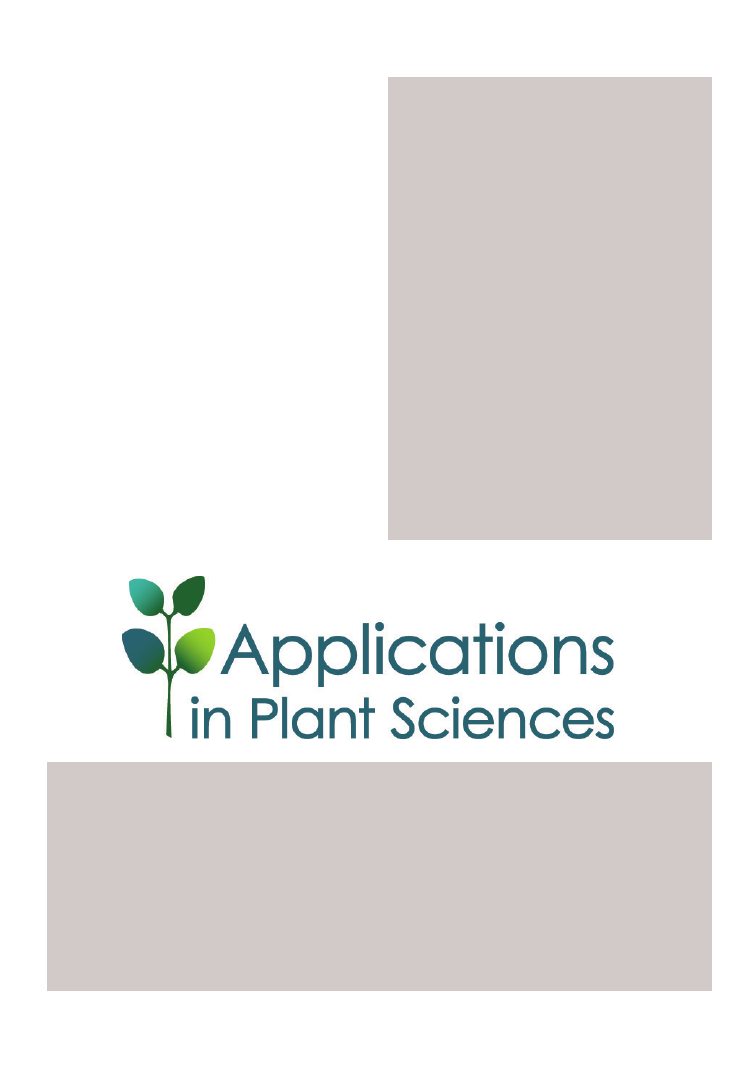
PSB 63 (1) 2017
16
Open Access collection (www.bioone.org/loi/
apps).
Article types and detailed Instructions for
Authors can be viewed at http://www.botany.
org/APPS/APPS_Author_Instructions.html.
Please contact the editorial office (apps@bota-
ny.org) with questions.
-By Theresa Culley (Editor-in-Chief), Univer-
sity of Cincinnati
Editorial office contact: Beth Parada, Manag-
ing Editor, apps@botany.org
What do authors think about the ex-
perience of publishing in
APPS?
“Thank you for such a quick turn-around
on our submitted manuscript. This is the
most efficient journal editing any of the
authors have experienced!”
“I was impressed by the quality and speed
of your publishing services, and I am
looking forward to seeing the article in
press. “
“It has been a pleasure working with you
on this review article. We truly appreci-
ate your time and attentiveness and are
thrilled with the final result.”
“I just saw the press release for my paper
on ScienceDaily and all over the internet.
Thanks a lot!”
Press releases for recent articles published in APPS
Measuring trees with the speed of sound: http://bit.ly/2hYHZUD
Drones take off in plant ecological research: http://bit.ly/2f0YrS2
HybPiper: A bioinformatic pipeline for processing #pageenrichment data: http://bit.
ly/2ls5VkC
To view all of APPS recent press releases, visit http://botany.org/files/main/folder/
SiteAssets/publications/apps/press-releases.

17
SPECIAL FEATURE
By Pamela Diggle
Professor, Department of
Ecology and Evolutionary
Biology
University of Connecticut
L
ast year, I was honored to be invited by the
BSA Graduate Student Representatives,
Rebecca Povilus and Angela McDonnell, to
give the keynote presentation at the “Interac-
tive Career Panel & Luncheon” during Botany
2016 in Savannah, Georgia. They suggested
that I share my thoughts on choosing a career
in botany and on making the most of a degree
in the plant sciences. As I pondered what I
might have to contribute on those topics, I
realized that I didn’t really choose a career
in botany—it chose me. The most important
thing that I’ve learned along the way is to do
what you love, and #iamabotanist.
My passion for plants has dictated most of
my career and choices along the way. It may
sound trite or self-indulgent: do what you
love. But I find that by focusing on what I per-
sonally find most rewarding, I am at my most
creative and I have my best insights. It also
helps me withstand those long hours of things
that are not so fun (insert your most dreaded
task here), like the gazillionth plant part that
Careers Beyond the Academy
you have measured or weighed. But how does
identifying what you find rewarding translate
into a career?
As an academic at a research 1 university,
mentoring graduate students is part of my job.
And it is a terrific part of my job that has giv-
en me an opportunity to interact with amaz-
ing people who share my love of plants. Over
the years, however, I have come to understand
that not all students—creative, accomplished,
and driven as they may be—aspire to careers
in academia. I also realized, however, that
I was ill equipped to help graduate students
navigate the world outside of academia, given
that other than a brief interlude after college, I
have only ever been an academic. How can I
advise and mentor students who aspire to jobs
beyond the academy?
As I continued to contemplate this topic of ca-
reers in botany, and particularly jobs outside
of academia, I was struck by the juxtaposi-
tion of two articles published just over a week
apart in the New York
Times:
“So Many Re-
search Scientists, So Few Openings as Profes-
sors,” and “The Incalculable Value of Finding
a Job You Love.”
The first article, by Gina Kolata, highlights
Emmanuelle Charpentier, who is widely
known for her role in deciphering the mech-
anisms of the CRISPR-Cas9 system (https://
www.nytimes.com/2016/07/14/upshot/so-
many-research-scientists-so-few-openings-

PSB 63 (1) 2017
18
as-professors.html). She recently became the
leader of the Max Planck Institute for Infec-
tion Biology, but had spent the previous 25
years moving through non-tenure track po-
sitions, in nine institutions, in five countries.
The article paints a fairly gloomy picture of
the outlook for new PhDs. It focuses more on
biomedical science, which has been particu-
larly hard hit by job shortages, but resonates
across the life sciences. The article’s author
summarizes a commonly held view (emphasis
added):
“The lure of a tenured job in academia is
great—it means a secure, prestigious posi-
tion directing a lab that does cutting-edge
experiments, often carried out by under-
lings. Yet although many yearn for such
jobs, fewer than half of those who earn
science or engineering doctorates end up
in the sort of academic positions that di-
rectly use what they were trained for.
Others, ending up in industry, business
or other professions, do interesting work
and earn lucrative salaries and can con-
tribute enormously to society. But by the
time many give up on academia—four to
six years or more for a Ph.D., a decade or
more as a postdoc—they are edging to-
ward middle age, having spent their youth
in temporary low-paying positions get-
ting highly specialized training they do not
need.”
These kinds of statements encapsulate com-
monly held assumptions about graduate
school: they assume that being a professor and
researcher with a giant lab is the ultimate goal
of all graduate students, that anyone in any
other job is an inferior also-ran, and that ac-
ademia trains you for nothing but academia.
All of which, in my experience, are false and
didn’t merit much further thought. But I was
motivated to explore the last assumption, that
academia prepares you for only academia.
What kinds of preparation are employers in
non-academic professions looking for? In
all that I read, and in discussions with people
in the private sector and various government
agencies, I heard over and over again that it
is easy enough to learn hard skills on the job
(various lab techniques, for example), and for
many non-academics, the job they have did
not exist when they were in graduate school,
so they could not have trained for it anyway.
The critical skills that non-academic employ-
ers are looking for include:
• Initiative
• Creativity
• Leadership skills
• Organization
• Project management
• Budget and finance
• Communication, both written and spoken
• Social media creation management
• Flexibility
Clearly, completing and publishing your dis-
sertation research requires all of these skills
and more. But you have to be able to demon-
strate this to a prospective employer. Com-
ing up with a dissertation project requires
initiative and creativity, problem solving, in-
sight, and thinking on your feet. What are
some specific examples from your research?
Non-academic employers look at a CV very
differently than a search committee in aca-
demia and will want specific examples of each
of the attributes listed above. In this day of

PSB 63 (1) 2017
19
highly collaborative work, it is critical that you
clearly establish ownership and take the intel-
lectual lead on your dissertation research. You
need to be able to demonstrate that you know
how to ask and answer original questions and
follow through until you get an answer. What
experiences do you have that most clearly il-
lustrate these qualities?
Employers are looking for leadership skills.
Did you direct a team of undergrads? How
did you ensure quality control? How did you
deal with problematic students? Did you take
the lead in a collaboration? How did you ne-
gotiate maintaining leadership within a group
of peers?
Organizational skills. Have you managed
large data sets? Complex experiments? Bud-
get and finance? You raised grant funding and
managed the budget for your research. Com-
munication? You give seminars and write pa-
pers for publication. Many of you teach and
do outreach.
Flexibility! Flexibility was valued highly by
everyone I spoke with: be flexible in where
you might live, how you see yourself, what
you view as science, what might be fulfilling.
For example, I had an interesting conversation
with a Zeiss Microscope representative. He
has a PhD in microbiology and says he never
saw himself as a sales person (and was perhaps
a bit disdainful of this career). But as a grad
student, he became an expert on many differ-
ent types of microscopy, primarily through
troubleshooting and problem solving as need-
ed for his research. Now he has a career solv-
ing microscopy issues for others. His career
combines his deep knowledge of biology with
his talent for optics and problem solving and,
he says, it is deeply satisfying.
You certainly gain skills from your disserta-
tion research that are valuable well beyond
academia. But, beyond your research, I also
encourage you to do other stuff! Everyone I
spoke to about careers outside of academia
emphasized that networking is critical and so
Many faculty and
graduate students view
as ideal the research
fellowship that allows
you to devote your
attention to research full
time with no need for
the distraction and time
commitment of a TA.
This view is reminiscent
of a “trade-school”
mentality; that graduate
school trains you to “be”
a research scientist and
nothing else. I prefer
to think of graduate
school as an opportunity
to develop the kinds of
skills that you need for
the career you want.
is serendipity. Take advantage of opportuni-
ties to meet people and enhance your “soft
skills.” Serve as a teaching assistant, even if
you are not required to and even if you find
it difficult at first. Teaching enhances your
communication, management, organization-
al, and leadership skills. Go to department
seminars no matter what the topic and sign
up to meet with the speaker. If nothing else,

PSB 63 (1) 2017
20
the seminar will give you a greater knowledge
base that increases your ability to connect
with other people, and talking with the speak-
er will enhance your networking skills. And
you can never predict who that person knows.
Take a leadership role in something outside of
your department, such as a professional so-
ciety or an advisor to an undergraduate club.
Use LinkedIn to find people with interesting
jobs and ask them questions. Contact people
who do interesting things and ask if you can
shadow them for a day. People are generally
accommodating and often happy to be asked.
Take advantage of your university alumni as-
sociation to make contacts with people who
have interesting careers.
Many faculty and graduate students view as
ideal the research fellowship that allows you
to devote your attention to research full time
with no need for the distraction and time
commitment of a TA. And, many faculty ad-
vise their students not to get “distracted” with
extra courses or activities. This view is rem-
iniscent of a “trade-school” mentality; that
graduate school trains you to “be” a research
scientist and nothing else. I prefer to think of
graduate school as an opportunity to develop
the kinds of skills that you need for the career
you want.
Which takes me to the second article, which
I highly recommend: “The Incalculable Val-
ue of Finding a Job You Love” (https://www.
nytimes.com/2016/07/24/upshot/first-rule-
of-the-job-hunt-find-something-you-love-to-
do.html) by Robert H. Frank.
There are many thoughtful resources
concerning careers for PhDs in
academia and beyond.
A few of these include:
• The Chronicle of Higher Ed “Vitae”
section (https://chroniclevitae.com/
job_search/new)
• Nature and Science have jobs sections
with interesting essays on careers in
the sciences (http://www.nature.com/
naturejobs/science/news; http://www.
sciencemag.org/careers)
• Alumni associations and career ser-
vices at your university
• "Next Gen PhD: A Guide to Career
Paths in Science" by Melanie V. Sinche
(http://www.hup.harvard.edu/catalog.
php?isbn=9780674504653)
You have already found something that you
love doing, or you would not be in graduate
school. For those of you who are consider-
ing career options beyond kinds of R1 institu-
tions where you are now, this article suggests
that rather than compiling a list of jobs that
are out there, think hard about what aspects
of graduate school bring you the most satis-
faction. When you are really “in the zone,” so
absorbed that you haven’t even looked at your
phone for hours, what are you doing? What
would it be like to do more of that? Then seek
out the kinds of experiences and contacts that
you will need for that career path.

21
SCIENCE EDUCATION
By Catrina Adams,
Education Director
BSA Science Education News and Notes is
a quarterly update about the BSA’s educa-
tion efforts and the broader education scene.
We invite you to submit news items or ideas
for future features. Contact Catrina Adams,
Education Director, at cadams@botany.org.
Over 2000 Students Conduct
Plant Science Investigations This
Fall Through PlantingScience.org
This past fall marked our largest Planting-
Science session ever. Thousands of students
worked with scientist mentors on their own
plant science investigations. Serving this
many students is only possible thanks to our
long-awaited new website, developed using
Purdue’s science collaboration platform HUB-
Zero. Thanks to all of our mentors, new and
experienced, who are volunteering their time
to inspire the next generation of plant scien-
tists. If you have been thinking about volun-
teering, next fall would be a perfect time to
join us. We’re expecting to double our num-
bers for fall, and we can use all the mentors we
can get. It’s a small time commitment, but you
can make a big impact on middle- or high-
school students. Most plant scientists had a
plant mentor at some point in their early lives,
someone who sparked an interest in plants
through their own enthusiasm. Through
PlantingScience you can be that plant mentor
that sparks a lifelong interest and enthusiasm
for plants. Sign up or direct your colleagues to
http://plantingscience.org/newmentor to sign up.
Congratulations to the Fall 2016 Star Project
teams (see the following page)! Each session
we choose 10 to 15 projects to feature in our
Star Project gallery. These projects represent
projects that have excelled in one of several
categories. Check out our Star Project Gallery
at https://plantingscience.org/starprojectgal-
lery to see what makes these 15 projects ex-
emplary.
Visit BRIT during Botany 2017
for a Tour or Workshop
The Botanical Research Institute of Texas
(BRIT) will be welcoming Botany 2017 at-
tendees to join them for a tour. Keep your eyes
on the schedule for times and details. Join
Gordon Uno and Marshall Sundberg for a
Sunday morning workshop, “Planting Inquiry
in Science Classrooms,” hosted at BRIT to learn
many practical techniques and activities you can
use to support your students’ active learning. At-
tendees at the workshop will receive a free print
copy of the book “Inquiring About Plants.”
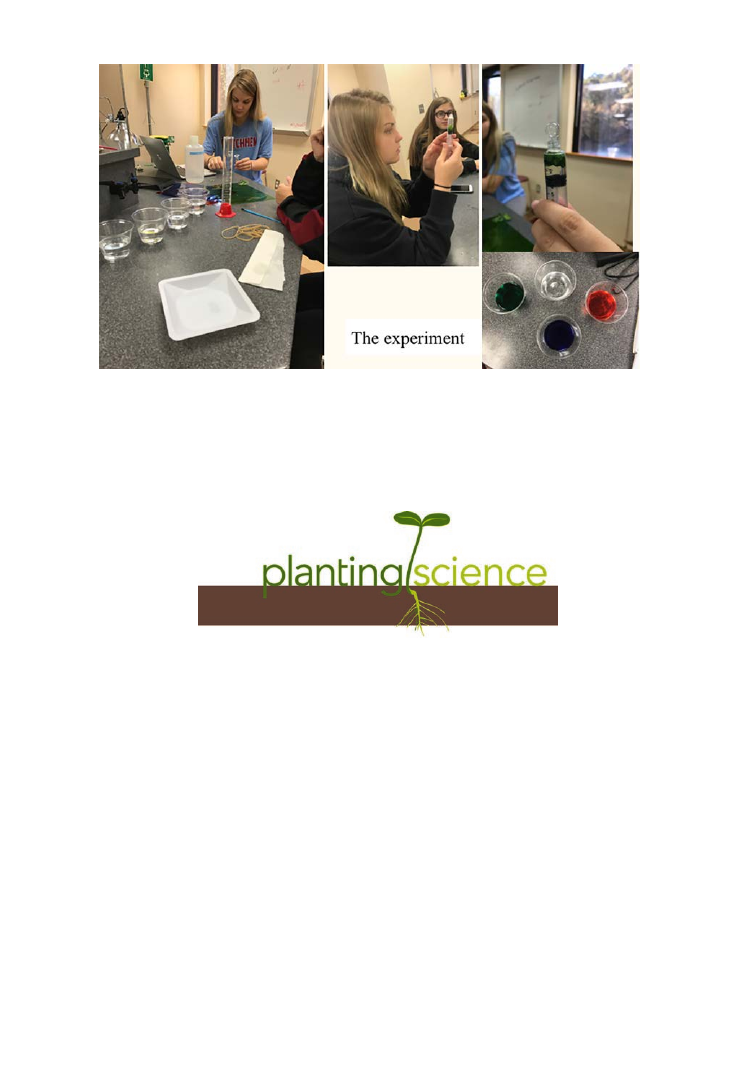
PSB 63 (1) 2017
22
Science Education
Life Discovery Conference—
Data: Discover, Investigate, Inform
(October 19-21, 2017)
Please consider joining us at this year’s Life Discovery Conference, a stand-alone education
conference for high school and undergraduate biology educators. The 2017 conference will
be held at the University of Oklahoma. This year’s theme is on data and quantitative literacy,
and will feature a number of workshops, field trips, and short presentations around best prac-
tices and tested activities for bringing data into your classroom. Have an activity under development
yourself that you’d like to share? We’re accepting proposals for the Education Share Fair where you can share
your in-progress ideas and get feedback from your peers. This is a great conference for networking with others
passionate about biology education, and there is lots of time to get to know other participants. For more infor-
mation, visit http://www.esa.org/ldc/.
Hope to see you there!
The “Power Plant Girlz,” one of 15 Star Project winners for the Fall 2016 Planting-
Science Session, conduct leaf disk flotation experiment around how different colors of
light affect photosynthesis. See more from the team on their Star Project Gallery Page at
https://plantingscience.org/spshingletonppg.

23
STUDENT SECTION
By Becky Povilus and James McDaniel
BSA Student Representatives
It’s a new year! You may be trying to figure
out what you can do in 2017 to help you reach
your education, research, and career goals.
Gathered here are upcoming opportunities
you might be interested in. Some deadlines
may have already passed, but they might be
things you’ll want to keep in mind for 2018!
We have four categories below for easy brows-
ing: Grants and Awards, Broader Impacts,
Short Courses and Workshops, and Job Hunt-
ing.
Round-up of Student Opportunities
Grants and Awards
Grants and awards can fund your research,
provide assistance for travel related to train-
ing or fieldwork, and even contribute to your
cost-of-living and tuition expenses (e.g., fel-
lowships). Additionally, applying for grants
and awards is a great opportunity to plan and
articulate your research. Lastly, remember to
check with your department or university for
internal grants that you can apply for.
BSA Graduate Student Research Awards
$500
Botanical Society of America
Research Funds
Support and promote graduate student research in the botanical sci-
ences. Includes the J.S. Karling Award.
Deadline: mid-March
More info:
botany.org/Awards
BSA Undergraduate Student Research Awards
$200
Botanical Society of America
Research Funds
Support and promote undergraduate research in the botanical sci-
ences.
Deadline: mid-March

PSB 63 (1) 2017
Student Section
24
More info:
botany.org/Awards
BSA Student Travel Awards
Variable, up to $500 Botanical Society of America
Travel (conference)
Several awards support student travel to the annual BOTANY con-
ference:
- Cheadle Student Travel Awards
- BSA Section awards
Deadline: early-April,
variable
More info:
botany.org/Awards
NSF Graduate Research Fellowship Program
$32k/yr + tuition aid National Science Foundation
Stipend & Tuition
Support outstanding graduate students in NSF-supported disciplines
who are pursuing research-based Master’s and doctoral degrees at
accredited U.S. institutions.
Deadline: October
More info:
www.nsfgrfp.org
NSF Doctorial Dissertation Improvement Grant
up to $13,000
National Science Foundation
Research Funds
Provide partial support of doctoral dissertation research for improve-
ment beyond the already existing project (check that your project
falls within the scope of associated Divisions).
Deadline: October
More info:
Click the “Funding” tab at www.nsf.gov
Torrey Botanical Society Fellowships and Awards
up to $2,500
Torrey Botanical Society
Research Funds &
Travel
Support research/education of student society members (fund field
work, recognize research in conservation of local flora/ecosystems,
fund course attendance at a biological field station). There are
awards for graduate students and undergraduates.
Deadline:
mid-January
More info:
www.torreybotanical.org
Prairie Biotic Research Small Grants
up to $1,000
Prairie Biotic Research, Inc.
Research Funds
Support the study of any species in U.S. prairies and savannas.
Deadline:
late-December
More info:
www.prairiebioticresearch.org
Botany In Action Fellowship
$5,000
Phipps Conservatory and Botanical Gardens
Research Funds
Develop new, science-based plant knowledge and chronicles tradi-
tional knowledge of plants. BIA promotes interactive scientific edu-
cation about the importance of plants, biodiversity, and sustainable
landscapes.
Deadline:
mid-January
More info:
https://phipps.conservatory.org/green-innovation/for-the-world/bota-
ny-in-action/call-for-proposals
The Lewis and Clark Fund for Field Research
up to $5,000
American Philosophical Society
Research Funds
Encourage exploratory field studies for the collection of specimens
and data and to provide the imaginative stimulus that accompanies
direct observation.
Deadline: early
February

PSB 63 (1) 2017
Student Section
25
More info:
www.amphilsoc.org/grants/lewisandclark
ASPT Graduate Student Research Grants
up to $1,000
American Society of Plant Taxonomists
Research Funds
Support students (both master’s and doctoral levels) conducting
fieldwork, herbarium travel, and/or laboratory research in any area
of plant systematics.
Deadline: early
March
More info:
www.aspt.net/awards
Richard Evans Schultes Research Award
up to $2,500
The Society for Economic Botany
Research Funds
Help defray the costs of fieldwork on a topic related to economic
botany, for students who are members of the Society for Economic
Botany.
Deadline: mid-March
More info:
www.econbot.org
Sigma Xi Grants-in-Aid of Research
up to $1,000
Sigma Xi
Research Funds
By encouraging close working relationships between students and
mentors, this program promotes scientific excellence and achieve-
ment through hands-on learning.
Deadline: mid-March
and October
More info:
www.sigmaxi.org/programs/grants-in-aid
Young Explorers Grant
up to $5,000
National Geographic Foundation
Research Funds
Support research, conservation, and exploration-related projects
consistent with National Geographic’s existing grant programs. In
addition, this program provides increased funding opportunities for
fieldwork in 18 Northeast and Southeast Asian countries.
Deadline: mid-March
and October
More info:
http://www.nationalgeographic.com/explorers/grants-programs/
yeg-application/
Systematics Research Fund
up to $5,000
The Systematics Association & The Linnean Society
Research Funds
Besides research focused on systematics, projects of a more general
or educational nature will also be considered, provided that they in-
clude a strong systematics component.
Deadline: Mid-Feb-
ruary
More info:
www.systass.org/awards
The Exploration Fund Grant
up to $5,000
The Exploration Fund Grant
Research Funds
Provides grants in support of exploration and field research for those
who are just beginning their research careers.
Deadline: mid Octo-
ber
More info:
www.explorers.org/expeditions/funding/expedition_grants
CIC Smithsonian Institution Fellowship
$32,700 for 1 year
CIC & the Smithsonian Institution
Stipend
One-year fellowships to support research in residence at Smithso-
nian Institution facilities. All fields of study that are actively pursued
by the museums and research organizations of the Smithsonian In-
stitution are eligible.
Deadline:
early-December
More info:
www.cic.net/students/smithsonian-fellowship

PSB 63 (1) 2017
Student Section
26
Ford Foundation Fellowship Programs
$24k-45k, for 1-3
years
Ford Foundation
Stipend
Three fellowship types are offered: Predoctoral, Dissertation, and
Postdoctoral. The Ford Foundation seeks to increase the diversity of
the nation’s college and university faculties.
Deadline:
late-November
More info:
http://sites.nationalacademies.org/pga/fordfellowships/index.htm
The Arnold Arboretum Awards for Student Research
$2,000-10,000
The Arnold Arboretum
Research Funds
Multiple awards or fellowships are offered for graduate students and
for undergraduates, with topics that focus on Asian tropical forest
biology and comparative biology of woody plants (including Chi-
nese-American exchanges). Check website for full information on
each award.
Deadline:
late-November
More info:
www.arboretum.harvard.edu/research/fellowships/
Garden Club of America Scholarships
$2,500-8,000
Garden Club of America
Research or Training
Funds
Many awards are offered to support botanical research, with foci
ranging from public garden history/use, field botany, medicinal bota-
ny, and horticulture. Check website for full information on each award.
Deadline:
January - February
More info:
www.gcamerica.org/scholarships
PLANTS Grant
Varies
National Science Foundation and Botanical Society of America
Travel (conference)
The PLANTS program will pay the expenses of up to 12 undergradu-
ates to participate in the BOTANY meetings as well as provide men-
toring from both peer and senior mentors in the plant sciences.
Deadline: March 1
More info:
https://botany.org/Awards/F_PLANTS.php
SMART Program
$25-38k/yr + tuition
American Society for Engineering Education
Stipend & Tuition
The SMART Program aims to increase the number of scientists and
engineers in the U.S. Department of Defense. The program is par-
ticularly interested in supporting individuals that demonstrate an ap-
titude and interest in conducting theoretical and applied research.
Deadline:
December
More info:
https://smart.asee.org/faq/
The Mohamed Bin Zayed Species Conservation Fund
up to $25,000
The Mohamed Bin Zayed Species Conservation Fund
Research Funds
The Mohamed Bin Zayed Species Conservation Fund is a new and
significant philanthropic endowment established to directly support
the cause of species conservation. It is open to applications for fund-
ing support from conservationists based in all parts of the world deal-
ing with plant and animal species.
Deadlines: February
28, 2017 & June 30,
2017
More info:
http://www.speciesconservation.org/

PSB 63 (1) 2017
Student Section
27
Fulbright U.S. Student Program
Varies
U.S. Department of State, Bureau of Educational and Cultural Affairs
Travel (abroad)
Offers a variety of grants for one year of study or research abroad to
over 100 countries. Applicants must have proficiency in the written
and spoken language of the host country.
Deadline: Septem-
ber
More info:
http://www.iie.org/fulbright#.WITr-rYrKrZ
STAR Graduate Fellowships
$44k/yr + tuition
U.S. Environmental Protection Agency
Stipend & Tuition
EPA’s STAR Graduate Fellowship program supports Master’s stu-
dents and doctoral candidates in environmental studies.
Deadline: between
April and May
More info:
https://www.epa.gov/research-grants#CurrentSta
r
PlantingScience
What it is:
A learning community where scientists provide online mentorship to
student teams as they design and think through their own inquiry proj-
ects.
What you can do: Interact with grade school-to-college students online, as they work on
plant-focused learning modules in the classroom.
More info:
www.plantingscience.org/
Science Olympiad
What it is:
Competitions are like academic track meets, consisting of a series of
23 team events in each division (middle school or high school). Each
year, a portion of the events are rotated to reflect the ever-changing na-
ture of genetics, earth science, chemistry, anatomy, physics, geology,
mechanical engineering, and technology.
What you can do: Mentor local students in person on a variety of science and engineer-
ing–oriented topics and skills; help organize and run competitions
More info:
www.soinc.org/
Local Arboretums, Parks, Museums, and Herbaria
What it is:
These institutions often depend on volunteers to donate their time and
expertise to help people of all ages enjoy their collections and grounds.
They may already have programs in place that allow you to lead tours
or interact with visitors at special events, so that you can share your
interests and passion.
What you can do: Lead tours; help organize and run events
More info:
Look up local parks/arboretums/museums/herbaria online, or inquire at
visitors’ centers.
Broader Impact Opportunities
These opportunities are not just for NSF grants! Sharing your passion for plants
and science with a wide range of audiences will help develop speaking skills as
well as help you reconnect with why you decided to go to grad school.

PSB 63 (1) 2017
Student Section
28
Advanced Field Botany
University of Idaho This two-week course is open to upper division undergraduates and
early career graduate students. In the course, you’ll gain valuable ex-
perience and botanical knowledge in the field. You’ll also get acquaint-
ed with the flora of Idaho in the Inland Northwest. Interested students
should look for an announcement in the spring.
June or July
More info:
www.webpages.uidaho.edu/dtank/AFB/Advanced_Field_Botany.html
Tropical Botany Summer Course
University of Flor-
ida
This course highlights the biology and systematics of tropical plants,
specifically the extensive holdings of tropical vascular plants at Fair-
child Tropical Garden, The Kampong of the National Tropical Botani-
cal Garden, and the Montgomery Botanical Center. Field trips will also
be offered to the Everglades, the Florida Keys, and other adjacent
natural areas. Be on the lookout for an announcement during the win-
ter months.
June or July
More info:
www.flmnh.ufl.edu/herbarium/news/tropicalbotany.htm
OTS Courses in Tropical Field Biology
Organization for
Tropical Studies
Courses through the Organization for Tropical Studies (OTS) are a
well-renowned way to spend a summer or semester in the field, learn-
ing about the biology of tropical ecosystems in Costa Rica and South
Africa. Course offerings include Tropical Plant Systematics, but check
their website for the full list of offerings.
Variable dates
More info:
www.ots.ac.cr
microMORPH & Arnold Arboretum Short-Course in Organismic Plant
Biology
Arnold Arboretum
of Harvard Univer-
sity
microMORPH summer short-courses give students a 2-week immer-
sive learning experience amid the expansive living collections and the
state-of-the-art microscopy facilities of the Arnold Arboretum. The top-
ic for 2017 is Plant Anatomy: Development, Function, and Evolution,
and applications are due by mid-April.
July 30 – August 12
More info:
projects.iq.harvard.edu/micromorph/courses-0
Molecular Evolution Workshop
Marine Biological
Library at Wood’s
Hole
This 10-day course features a series of lectures, discussions, and
bioinformatics exercises. Included are sessions on phylogenetic anal-
yses, population genetics analyses, databases and sequence match-
ing, molecular evolution, and comparative genomics. Applications for
participation are due on April 7, 2017.
July 17-27
More info:
molevol.mbl.edu/index.php/Main_Page
Short Courses and Workshops
These are a great way to learn new research skills, which can also be added to your CV or resume.
Here are a few of the many options available to grad students for part of a semester or summer.

PSB 63 (1) 2017
Student Section
29
Bodega Bay Applied Phylogenetics Workshop
UC Davis and the
Bodega Marine
Laboratory
This week-long course will cover topics in statistical phylogenetics and
give students the opportunity to complete a project during the course.
The schedule will likely include sessions on Bayesian interference,
divergence-time estimation, MCMC diagnosis and model selection,
biogeography, continuous and discrete trait evolution, species tree in-
ference, and rates of lineage diversification.
March 11-18
More info:
www.treethinkers.org
The R Basics Workshop
Missouri Botanical
Garden
This workshop is one way to get exposure and experience working
with R, a powerful statistical software package. No dates are currently
set for the next 3-day crash course, but it is likely that it will be taught
again next May in St. Louis by scientists from the Center for Conser-
vation and Sustainable Development. Look out for a formal announce-
ment in December or January and watch the website.
To be announced
More info:
www.rbasicsworkshop.weebly.com
edX: Data Analysis for the Life Sciences
online
edX, a free online course provider, offers a 7-part course on data anal-
ysis for the life sciences (PH525.1-7). These courses are a self-paced
way to learn R for statistical analysis, starting with basic R use to deal-
ing with genomic datasets. These courses combine video lectures,
practical exercises, and a discussion board monitored by course de-
velopers.
Variable times
More info:
Search “PH525” on www.edx.org
Masters/PhD/Post-Doctoral Opportunities
These types of jobs are easily searchable on the “EvolDir” website under “PostDocs” and
“GradStudentPositions”. Click the icon, and listings will pop up in a list from the newest to the
oldest. This site shows positions from across the biological sciences, but it is a great option
for plant evolutionary biologists.
EvolDir
www.evol.mcmaster.ca/brian/evoldir.html
Academic Teaching Positions
Check the BSA website: click on the “Careers/Jobs” tab, and you can select the “Post-doctor-
al, Fellowship, and Career Opportunities” link to see a current list of a variety of job postings.
The BSA website is a great resource for one-stop-shopping for careers and other opportuni-
ties in a variety of botanical sciences. Another good resource for finding jobs (including post-
doctoral opportunities) can be found through AAAS, at the Science Careers site.
Botanical Society of America jobs.botany.org
What’s Next: Looking for a Job in Botany
Before you complete your degree, or if you are looking to switch jobs, it is important
to consider your next step—whether it be finding a PI and lab to work in for continu-
ing your education, finding a post-doctoral research opportunity, or finding a job that
suits your goals and skills. Finding out about jobs often happens through personal
contacts, but there are great online resources as well.
jobs.sciencecareers.org/jobs/botany-plant-science
AAAS Science Careers

PSB 63 (1) 2017
Student Section
30
Government Positions and Non-Academic Jobs
Searches for government jobs can begin at usajobs.gov and americajobs.com. A good re-
source for non-academic jobs is the Conservation Job Board; this site allows you to search
within various fields by state and is updated regularly. Networking sites like LinkedIn and
ResearchGate will help you connect with and organize your professional contacts—be sure
keep you profile pages updated and polished!
Government Positions
www.usajobs.gov
www.americajobs.com
Conservation Job Board
www.conservationjobboard.com/category/botany-jobs
Use your University!
Many academic institutions have offices that focus on helping alumni succeed after gradu-
ation. Check with your department or institution for resources on job announcements, work-
shops focused on personal development (such as CV/resume writing or getting a teaching
certificate), and networking opportunities.
FROM THE
PSB
ARCHIVES
60 years ago: “The vote on the question posed in the Oct. 1956 number of PSB, namely, should PSB be contin-
ued beyond its two-year trial period, now stands at 293 in favor of continued publication, 2 opposed to contin-
ued publication. While this vote does not represent a majority of Bot. Soc’s. members, it doubtless represents
a fair sample of the opinions of our members. Thus, publication of PSB will doubtless continue, although the
Council has not yet had the opportunity to render an official decision.”
-Future of the Plant Science Bulletin PSB 3(1): 6
50 years ago: “Flora North America, as the project will be called, was officially launched on January 30, 1967
when the newly formed Editorial Committee held its first meeting at the Smithsonian Institution in Washing-
ton, D.C. This three-day meeting, convened by William L. Stern (Smithsonian), Chairman pro terra. of the
Steering Committee, was attended by all members of the Editorial Committee.”
-Shetler, Stanwyn G. Flora North America Launched PSB 13(1): 5.

31
ANNOUNCEMENTS
Eagle Hill Institute Natural
History Science 2017 Field
Seminars
Eagle Hill Institute, located on the eastern
coast of Maine, will host seminars and work-
shops focusing on natural history during
Summer 2017. These workshops are in sup-
port of field biologists, researchers, field natu-
ralists, faculty members, students, and artists
with interests in the natural history sciences.
Courses include “Sedges and Rushes: Identi-
fication and Ecology”; “Identification, Biol-
ogy, and Natural History of Ferns and Lyco-
phytes”; “Field Botany and Plant Ecology of
the Eastern Maine Coast”; “Bogs and Fens:
Maine Peatlands”; “Mosses: Structure, Ecol-
ogy, and Identification”; “Survey of Grasses:
Their Structure, Identification, and Ecology”;
and “Field Botany and Plant Ecology of the
Eastern Maine Coast”, among many others. A
full list of 2017 seminars and workshops, as
well as registration information, can be found
at
https://www.eaglehill.us/programs/nhs/
nhs-calendar.shtml.
Pam and Doug Soltis
Awarded the
2016 Darwin-Wallace Medal
Doug and Pam Soltis have been awarded the
2016 Darwin-Wallace Medal. This award,
presented by the Linnean Society of Lon-
don, recognizes their groundbreaking work
in the study of evolution and diversification
in angiosperms, including in phylogeny re-
construction, genome evolution, phylogeog-
raphy, and many other topics. The official an-
nouncement of this award can be found in The
Linnean 32(2): 35-36.
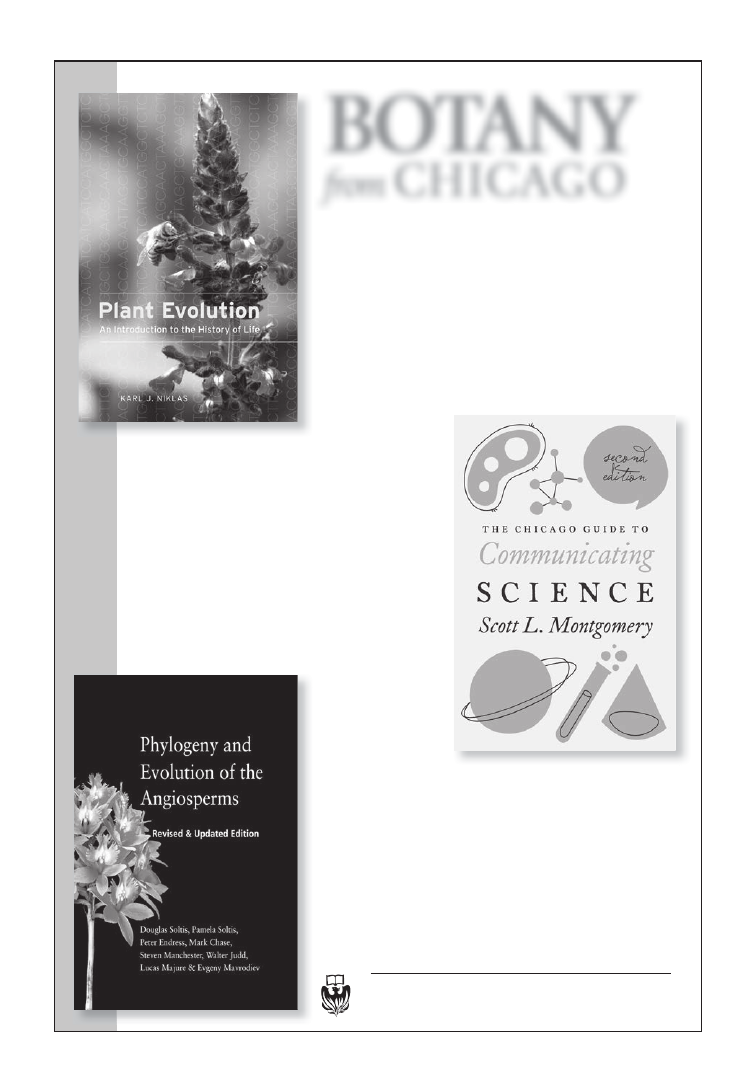
PSB 63 (1) 2017
32
Plant Evolution
An Introduction to the History of Life
Karl J. Niklas
“In a true tour de force, Niklas assays the mechanisms and
patterns of evolution, from molecules to ecosystems, using
plants as examples. Must-reading for plant scientists,
Plant Evolution will both delight and challenge everyone
who peers into the heart of biology.”—Andrew Knoll,
Harvard University
Paper $45.00
BOTANY
from
CHICAGO
N
EW
E
DITION
The Chicago Guide to
Communicating Science
Second Edition
Scott L. Montgomery
“Montgomery acknowledges that the training of sci-
entists, unlike higher education in the humanities, has
long excluded the formal development of writing, oral
presentation, and editing. But he sets out to dispel
the notion that scientists are inherently less skilled
at the art of communication. . . . Armed with a little
more knowledge of the basic tenets of writing, he says,
any scientist can write with eloquence.”—Science
Paper $25.00
N
EW
E
DITION
Phylogeny and Evolution
of the Angiosperms
Revised and Updated Edition
Douglas Soltis, Pamela Soltis, Peter Endress,
Mark Chase, Steven Manchester, Walter Judd,
Lucas Majure, and Evgeny Mavrodiev
“Excellent. . . . Highly recommendable for anyone involved in
plant systematics.”—Plant Science Bulletin, on the first edition
Cloth $80.00
Forthcoming in August
The University of Chicago Press
www.press.uchicago.edu

PSB 63 (1) 2017
33
In Memoriam
Thomas Norwood Taylor
(1938—2016)
It is with profound sadness that we acknowl-
edge the passing of Dr. Thomas N. Taylor,
Roy A. Roberts Distinguished Professor of
Ecology and Evolutionary Biology at the Uni-
versity of Kansas, Curator of Paleobotany in
the Biodiversity Institute and Natural History
Museum at University of Kansas, and senior
paleobotanist in the National Science Foun-
dation U.S. Antarctic Program. Tom died at
home in Lawrence, Kansas on April 28, 2016
after several years of battling cancer, and in so
doing has left his discipline, his students, and
his colleagues far poorer for his loss. In char-
acteristic fashion for his indomitable person-
ality, Tom was to be seen working at his desk
less than a month before his death.
Tom Taylor was an Ohio boy, who earned his
B.A. in Botany at Miami University (of Ohio)
in 1960, and his Ph.D. in paleobotany in Wil-
son Stewart’s lab at the University of Illinois
in 1964. He then moved to Theodore Delevo-
ryas’ lab at Yale University for postdoctoral
work in 1964 and 1965. At that time, coal
ball studies were among the most active areas
of paleobotanical investigation, and Tom fo-
cused his studies on the morphological and
anatomical characterization of ovules assign-
able to medullosans and other seed ferns, on
ferns, and on equisetophytes. In 1965, Tom
accepted an Assistant Professorship at the
University of Illinois at Chicago Circle, where
he continued his studies of anatomically pre-
served Pennsylvanian and Mississippian age
plants. During that period Tom worked close-
ly with Donald A. Eggert, who he recruited
from the University of Iowa and with whom
he built massive collections and an extremely
active program to study permineralized fos-
sil plants at U.I.C.C. During those early years
Tom began focusing on the ultrastructure of
pollen and spores, for which he pioneered use
of the scanning electron microscope in botan-
ical studies, and developed many of the trans-
mission and scanning electron microscopy
techniques that are in common use today.
Although he had been promoted to Professor
of Biological Sciences by 1971, Tom moved
his laboratory and students to Ohio Univer-
sity in 1972, and then moved onto the Ohio
State University in 1974, where he chaired the
Department of Botany until 1978. In 1982 he
joined the Byrd Polar Research Center at Ohio
State, and began characterizing the Permian,
Triassic, and Jurassic vegetation of Antarctica,
a loving endeavor that he continued to pursue
for the rest of his life.

PSB 63 (1) 2017
34
Originally stimulated by the early Antarctic
work of James Morton Schopf, Tom’s studies
of the late Paleozoic and Mesozoic plant bio-
tas of Antarctica have dramatically expanded
our knowledge and understanding of plant
evolution and vegetational turnover on the
continent of Gondwana. Also beginning in
the 1980s, Tom hosted Argentine senior sci-
entist Sergio Archangelsky, as well as post-
doctoral researchers Georgina del Fueyo, Ana
Archangelsky, Ruben Cuneo, and Ignacio Es-
capa. Those studies dramatically broadened
the scope of studies on the South American
biotas of Gondwana and produced life-long
collaborations with Argentine colleagues.
In 1981, Tom hosted a sabbatical leave for
his close friend and chytridalean mycologist,
Charles E. Miller of Ohio University. That
collaboration spurred his interest in fos-
sil fungi, and laid the groundwork for Tom’s
pioneering development of the discipline of
paleomycology. Initially focusing on fungi
in Pennsylvanian age coal balls, Tom’s inter-
ests quickly extended to the Lower Devoni-
an Rhynie Chert, which he first studied with
Winfried Remy. For more than 30 years Tom
collaborated extensively with Hans Kerp, Ha-
gan Hass, Michael Krings, and others to fun-
damentally reinterpret the scope of biological
interactions that can be inferred from the fos-
sil record. Those efforts have recently been
compiled in the first comprehensive paleomy-
cology textbook, “Fossil Fungi” (2015), which
Tom co-authored with Michael Krings and
Edith Taylor.
In 1995 Tom retired from The Ohio State
University, but in characteristic “Taylorian”
fashion, he did not retire from scholarship.
Rather, Tom moved to the University of Kan-
sas, where he accepted the positions of Dis-
tinguished Professor in Botany, Curator of
Paleobotany in the Biodiversity Institute and
Natural History Museum, and Courtesy Pro-
fessor in Geology. Following establishment of
the Department of Ecology and Evolutionary
Biology at KU, Tom served as chair of the new
department for three years before focusing
his seemingly boundless energy on research,
student mentoring, fieldwork, and classroom
teaching.
Along the way, Tom found the time to deliver
several hundred papers at scientific meetings,
publish 468 peer-reviewed journal articles
and book chapters, edit four books of scien-
tific contributions, and author four textbooks,
including three paleobotany textbooks and
the first comprehensive compendium on fos-
sil fungi. Tom’s mentorship is legendary for
the numbers of students graduated (M.S. = 11,
Ph.D. = 14), postdoctoral researchers super-
vised (19), long-term researching guests to his
laboratory (26), and for the creativity of his
advice, the high level of his expectations, and
the continuing support he generously provid-
ed to all. For his students, colleagues, and col-
laborations, he became both an inspirational
colleague and a steadfast friend.

PSB 63 (1) 2017
35
Tom was extremely proud of the nearly 60
externally funded research grants, including
more than 50 years of continuous support
from the National Science Foundation. More
importantly, however, he was most gratified
that such funding allowed him to offer unpar-
alleled support for the mentoring of students
and for the development of collaborations
with colleagues from around the globe. While
Tom took in stride his own unparalleled suc-
cess in plant paleontology and paleobiology,
his colleagues did not, and he was the recipi-
ent of numerous awards and honors. Among
those that are most illustrative of the stature in
which he is held are the Distinguished Teach-
ing Award from The Ohio State University
(1989) that recognized his commitment to
students, the Alexander von Humboldt Senior
Research Award (1994–1996) that initiated
Tom’s work on the Rhynie Chert, and the Pa-
leobotanical Section of the Botanical Society
of America Award for a lifetime of contribu-
tions to Paleobotany (2012). His colleagues’
appreciation for his service is also reflected in
his election as President of the International
Organisation of Palaeobotany (1994–1997),
and the National Science Board recognition
he received for outstanding service to science
(2006–2012). On the flight back from Mc-
Murdo Base in Antarctica in 1994, Tom re-
plied to my prediction that he would soon be
elected to the National Academy of Sciences
by saying that he was far too independent to
ever be accepted into that group. Only three
months later we received the announcement
that he had, indeed, been so elected.
Tom Taylor is clearly one of the most influ-
ential plant scientists of our time. Through
his indomitable pursuit of excellence, his
tireless development of new approaches and
techniques, his thoughtful establishment of
awards and programs to benefit students, his
continuous contributions to the development
of scientific societies and institutions, and his
steadfast support of colleagues, Tom Taylor
has dramatically elevated the quality and stat-
ure of paleobiological inquiry.
On a personal note, I shall always be grateful
that in 1967 Tom accepted into his laboratory
a masters student of rather equivocal poten-
tial, and also for the subsequent 50 years of
guidance, support, criticism, encouragement,
and inspiration that he continued to offer. I
am delighted to recall that his passion for life
was equaled by his fierce loyalty to those he
loved. Tom was a devoted husband to his wife
Edith Taylor, and a loving father to his seven
children, and his grandchildren. Biological
or scholastic, we were all family to Tom. It
is hard to realize that I can no longer call his
office to hear the familiar “Taylor” that would
signal the beginning of a warm and enlighten-
ing conversation with my trusted mentor and
fast friend. He is badly missed.
By Gar Rothwell
Ohio University, and
Oregon State University

PSB 63 (1) 2017
36
Hugh Iltis
(1925–2016)
Hugh H. Iltis, Ph.D., 91, passionate and out-
spoken advocate for preservation of the natu-
ral world, died December 19, 2016, after a long
and full life. A larger-than-life figure to all who
knew him, Iltis was born in Brno, Czechoslo-
vakia on April 7, 1925. His father, Hugo, was a
botanist, educator, and biographer of Mendel,
the founder of genetics. Because Iltis’s father
was Jewish and a left-wing political activist, he
was targeted by the Nazis and, with the help
of Albert Einstein, the family left Brno for the
United States in 1938, settling in Virginia.
After a year at the University of Tennessee, Iltis
entered the U.S. Army during WWII, spend-
ing 1944-46 in Europe as a medic, interroga-
tor of captured German officers, and later as
an intelligence officer, preparing documents
for the Nuremburg trials. He received his B.A.
degree from the University of Tennessee and
his Ph.D. at Washington University and the
Missouri Botanical Garden in St. Louis.
Following three years of teaching at the Uni-
versity of Arkansas, Iltis spent nearly 40 years
(1955–1993) as Botany professor and Direc-
Ph
ot
o cr
ed
it t
o B
ren
t N
icas
tro
.
tor of the Herbarium at the UW-Madison,
growing the herbarium to house over 1 mil-
lion dried plant specimens. His taxonomic re-
search focused on Capparidaceae and on Zea,
working primarily in Mexico and the tropics.
Iltis led numerous expeditions to many parts
of the world to search for new plant species,
travelling on mule or horseback when neces-
sary.
Teaching his courses with enthusiasm and
dramatic flair, he educated students on the
importance of integrating taxonomy, bioge-
ography, ecology, and evolution. He advised
36 graduate students, many of whom have
gone on to impressive research and academ-
ic careers in botany. The lobby of Birge Hall
for a few years was filled (to the dismay of
some administrators) with donated scientif-
ic books and journals, ultimately filling two
semi-trailer trucks, bound for the University
of Guadalajara. In later years, he turned his
book donating primarily to the UW-Madison
libraries.
Iltis authored dozens of scientific papers and
book chapters, environmental writings, and
the Atlas of the Wisconsin Prairie and Savanna
Flora, co-authored by Ted Cochrane.
In defense of the flowers, butterflies, birds and
children, Iltis spoke out forcefully against the
mindless consumption of material posses-
sions, the heedless destruction of biological
diversity, and the unsustainable increase in
human population, the root cause of our en-
vironmental crisis. He was a strong support-
er of abortion rights. His role in all aspects of
his career was to stir up people, to confront
people with the hard reality of what must be
done to preserve the quality of the natural en-
vironment for human survival and for scien-
tific study.
Of the world’s nine known species of toma-
toes, Iltis discovered two of them when he
travelled to Peru on a $20,000 NSF grant
from November 1962 to February 1963 ac-
companied by then wife Carolyn Merchant
and Ph. D student Don Ugent and his wife.
One of those two wild tomato species discov-

PSB 63 (1) 2017
37
ered, proved 17 years later to be worth many
millions of dollars a year to the industry—an
over ten-thousand-fold sensational return on
a small research investment, which may ulti-
mately be dwarfed by the yet-unknown value
of the over 20,000 specimens collected on that
trip including many new endemic species.
It is thus all the more inexcusable that while
much of the world’s biodiversity is disappear-
ing overnight before we even know what has
been lost, funding for basic scientific research
continues to face sharp cuts.
His preservation efforts were successful in
Wisconsin, Hawaii, and Mexico. Iltis was
co-founder in 1960 of the Wisconsin Chap-
ter of the Nature Conservancy. In 1967 he
instigated formulation of Hawaii’s Natural
Areas Law, which was enacted in 1970, and
on the 20
th
anniversary (1990) he was recog-
nized “for outstanding service to the Hawai-
ian environment.” In 1968 he was part of a
small group, including Hugh’s colleague Orie
Loucks, whose activism led to the outlawing
of DDT in Wisconsin, which led, ultimately, to
a national ban. Following his sensational dis-
covery with Mexican botanist Rafael Guzman,
of Zea diploperennis (perennial teosinte, and
close relative of cultivated corn, Z. mays) in
Mexico in 1977, he played a pivotal role in es-
tablishing the 345,000-acre Sierra de Manant-
lan Biosphere Reserve in the State of Jalisco,
the first time an international biosphere re-
serve was founded around the site of a rare,
endemic species whose germplasm holds the
only known source of genetic resistance to
various corn viruses and corn rust disease and
thus is of potentially enormous economic val-
ue. The Sierra de Manantlan is two thirds the
size of the Great Smoky Mountains Nation-
al Park, another place that Iltis loved and to
which he led field trips. For this effort, in 1987
he received the Republic of Mexico’s Presiden-
tial Award from then President De La Madrid.
More importantly, it has launched the further
education of a number of accomplished Mexi-
can botanists and environmentalists.
Other awards that Iltis received during his
career were the Sol Feinstone Environmental
Award (1990), National Wildlife Federation
of Merit Award (1992), Society for Conser-
vation Biology Service Award (1994), the Asa
Gray Award by the American Society of Plant
Taxonomists (considered the top award in the
field of taxonomy) (1994), the Merit Award
from the Botanical Society of America (1996),
the University of Guadalajara’s Luce Maria
Villareal de Puga Medal (1994), and an hon-
orary degree from the University of Guadala-
jara.
He always shared liberally, be it authorship of
papers, credit for discoveries, or even a place
to live—as a number of Mexican students who
gained Masters or Ph.D. degrees at the UW
lived in his home for sometimes months at a
time. He worked with dozens of institutions in
Latin America, making a strong contribution
to the development of science, and developing
strong collaborative ties with researchers in
those countries.
As early as 1964, Iltis argued that the most
profound reason why we should preserve the
natural world was human’s innate need for
natural beauty and diversity. The cover page of
his copy of E. O. Wilson’s Biophilia bears Wil-
son’s inscription, “To HHI, the pioneer in the
field.” Iltis loved prairies, studied them, and
wrote and spoke passionately in their defense.
Two prairie and savannah areas in Wisconsin
now bear his name.
Hugh is survived by his four sons, Frank and
Michael of Madison, David of Salt Lake City,
and John of Minneapolis, and friends and
colleagues. He was preceded in death by his
father, Hugo; mother, Anni; brother, Wilfred;
and wife, Sharyn Wisniewski.
It is suggested that contributions in Hugh Il-
tis’s name be directed to the Wisconsin Chap-
ter of the Nature Conservancy or to The Prai-
rie Enthusiasts.
http://www.nature.org/ourinitiatives/regions/
northamerica/unitedstates/wisconsin/index.
htm
http://www.theprairieenthusiasts.org/
-By Michael Iltis
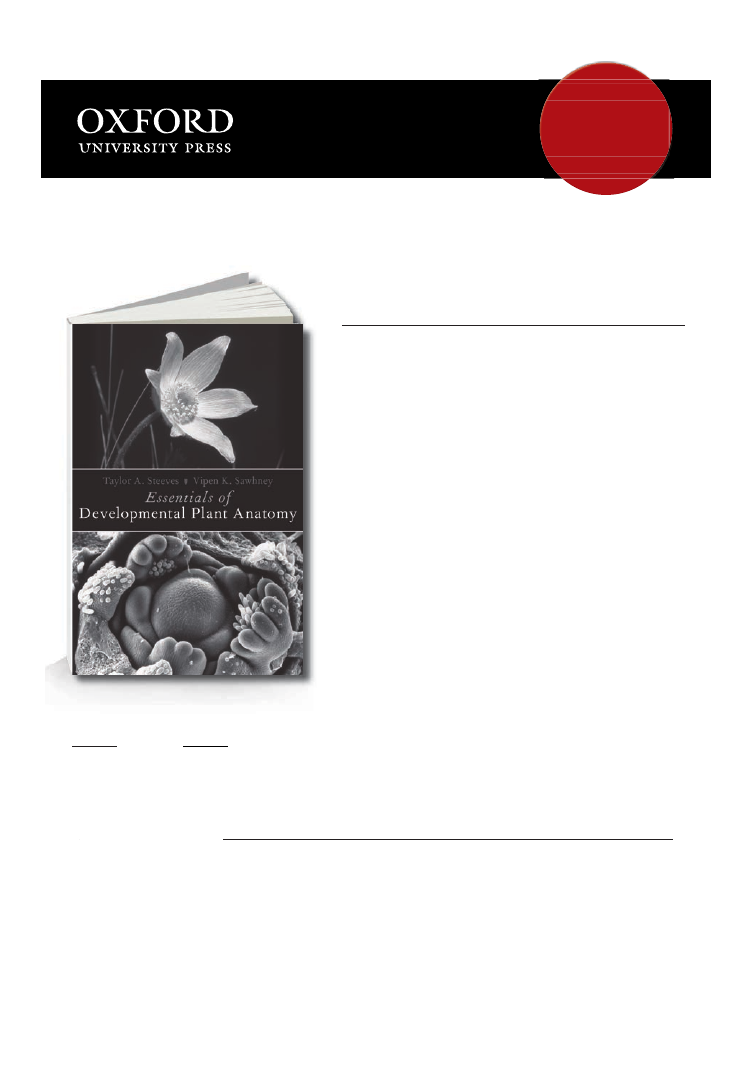
PSB 63 (1) 2017
38
Taylor A. Steeves, University of
Saskatchewan, and Vipen K. Sawhney,
University of Saskatchewan
• The first comprehensive account of developmental
plant anatomy on the market in years
The main aim of this book is to provide a
developmental perspective to plant anatomy.
Authors Steeves and Sawhney provide fundamental
information on plant structure and development to
students at the introductory level, and as a resource
material to researchers working in nearly all areas of
plant biology including plant physiology, systematics,
ecology, developmental genetics, and molecular
biology. The book is focused on angiosperm species
with some examples from different groups of plants.
Claim your
30% discount
when you order online today*
30%
ONLINE
DISCOUNT*
Ordering Details
ONLINE www.oup.com/academic/biology
POSTAGE & DELIVERY
For more information about postage charges and delivery times visit ww.oup.com/academic/help/shipping/.
*only when you order directly via www.oup.com/academic/, adding promotion code ASPROMP8 to your shopping basket.
Discount valid until 31/07/2017. Limit 10 copies per transaction. This offer is only available to individual (non-trade)
customers . This offer is exclusive and cannot be redeemed in conjunction with any other promotional discounts.
The specifications in this leaflet, including without limitation price, format, extent, number of illustrations, and month of publication, were as accurate as possible at the time it went to press.
JANUARY 2017 | 184 PAGES
978-0-19-065705-5 | HARDBACK
£45.99
£32.19
|
$69.95
$48.97
Essentials of Developmental Plant Anatomy
The late Professor Taylor A. Steeves served as the department
head for many years of the Biology Department at the
University of Saskatchewan.
Vipen K. Sawhney is Professor Emeritus and former Head of
the Biology Department at the University of Saskatchewan.
Both Professors Steeves and Sawhney are internationally
known developmental botanists and have received several
awards including the Lawson medal from the Canadian
Botanical Association, and Master Teacher Award from the
University of Saskatchewan.

39
BOOK REVIEWS
Conservation
Complexity: The Evolution of Earth's Biodiversity and the Future of Humanity ..........39
Ecology
Plant Functional Diversity: Organism Traits, Community Structure, and Ecosystem
Properties ............................................................................................................................................................41
On the Forests of Tropical Asia: Lest the Memory Fade .......................................................43
Economic Botany
Handbook of Cucurbits: Growth, Cultural Practices, and Physiology ...............................45
The Book of Spice: From Anise to Zedoary ...................................................................................46
Education
A Botanist’s Vocabulary: 1300 Terms Explained and Illustrated .........................................48
History
Plant: Exploring the Botanical World ....................................................................................................49
Systematics
Name Those Grasses: Identifying Grasses, Sedges and Rushes .....................................51
Agaves, Yuccas, and Their Kin: Seven Genera of the Southwest .....................................53
Guide to the Vascular Flora of Howell Woods, Johnston County,
North Carolina, U.S.A. ....................................................................................................................................54
Native Plants for Southeast Virginia, including Hampton Roads Region ........................54
CONSERVATION
Complexity: The Evolu-
tion of Earth's Biodiver-
sity and the Future of
Humanity
William C. Burger
2016.
ISBN-13: 978-1-63388-193-8
Hardcover, US$26.00. 380 pp.
Prometheus Books, Amherst,
New York, USA
Complexity describes the background of bio-
diversity on our planet, and, as the book’s
subtitle states, the future of humanity. In fact,
when I came across it, this subtitle made me
curious and prompted me to read and review
this book. Who is the author? William C.
Burger is a biologist, botanist, ecologist, writ-
er, and has been Chair and Emeritus Curator
of Botany at the Field Museum of Natural
History in Chicago. He is highly qualified to
write a book on this topic, and he claims to be
a pessimist.
From the beginning, Complexity is different
from standard ecological textbooks because

PSB 63 (1) 2017
40
Book Reviews
the author tries to involve interested readers
with a general educational background as well
as scientific peers. To do so, and to capture
his audience´s attention, the author starts at
comparably low level of biology, and proceeds
stepwise to higher levels of complexity. The
problem with complexity and biodiversity is
that related research is rooted in many differ-
ent disciplines. Systematics, phylogeny, bioge-
ography, and ecology have to be covered, as
well as conservation biology, biochemistry,
and, when humans are involved, paleontolo-
gy, anthropology, and cultural sciences. The
author collects examples and insights from all
these disciplines, keeping the reader fascinat-
ed, not at least because he is a dedicated teach-
er, as well as a brilliant researcher with ample
experience abroad from many expeditions to
unravel biodiversity.
Subdivided in 12 chapters, the book builds up
stepwise like a series of lectures, covering ba-
sic knowledge in Chapters 1 to 6 and moving
to more branched and outreaching aspects in
Chapters 7 to 10. The first 200 pages cover the
evolution of life on earth and the catastrophes
that have shaped diversity in chapters that
could well stand alone as essays.
In the end, the gentle reader has been guided
through all kinds of different biomes or hab-
itats, through the whole field of biodiversity,
from billions of beetles to trillions of transis-
tors. While the latter is not really biodiverse,
but rather a technological means to under-
stand its complexity, it is indispensable to un-
derstand human superiority on this planet.
Did you know that gymnosperms are not very
clever, and why that is the case? You´ll learn
about that in this book. You will also learn why
life on earth permanently opposes the second
law of thermodynamics, or why you can mow
your lawn but not your petunias. Or how bi-
pedalism and swinging arms made our brains
larger. Filled with impressive examples, some-
times purposefully redundant, with anecdotes
and quotations from key publications on the
topic, the book is more than fun to read—it is
truly impressive. On one page, the author re-
ports on being bitten in tender regions of his
body by protective ants, a literary highlight
in itself. Elsewhere, he describes how he has
witnessed unexplainable but severe damage to
old preserved forest reserves around the Great
Lakes, and the loss of biodiversity due to the
loss of pollinators in the Great Prairies. Even
more important, William Burger´s book pro-
vides a plethora of facts about why our evo-
lutionary history can never support a six-day
creation 10,000 years ago.
Written in a colorful style and using bril-
liant examples, the first 10 chapters provide
the foundation for Burger´s main argument.
Hence, after having presented the reader
with an outline of the evolution of diversity
on earth, in Chapter 11 Burger summariz-
es the contents of the first 10 chapters in the
book before focusing in Chapter 12 on hu-
man development and human prospects in
an ever-challenging world. This last chapter
is of utmost importance. We are adding more
complexity to this world, and we are expand-
ing the information content of the planet by
exploiting all available resources, and perma-
nently inventing or improving novel technol-
ogies. Burger describes optimistic viewpoints
of fellow scientists, but nevertheless pres-
ents a pessimistic view of human future and
development. Here he turns away from the
biodiversity- or ecology-driven focus of the
book—human complexity develops as our
technologies emerge. In a modern society,
the most important driver is information and
the complexity within this information. He
is afraid, as every insightful biologist should
be, that our sheer numbers, the ever-increas-
ing birthrates and the thoughtlessness of our
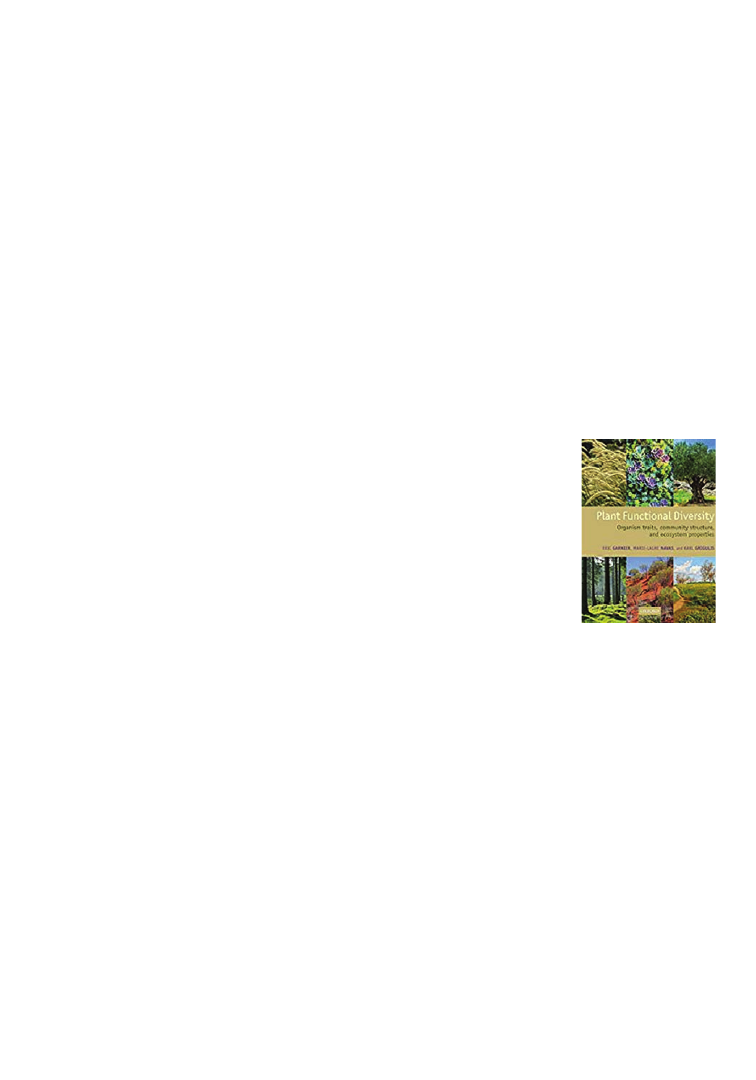
PSB 63 (1) 2017
41
Book Reviews
technologies are eroding the planet´s diversity
so that we are, without any doubt, undermin-
ing the base of our own survival on the blue
planet in the long term.
The monstrous volumes of coal and oil, the in-
credible amounts of minerals and ores that we
consume daily, and the enormous energy that
we use combine to dash hopes of reducing
carbon footprints or stopping climate change.
Burger is severely concerned about human life
and future, and throughout the book, specif-
ically in Chapters 10 to 12, he provides proof
for his pessimistic view.
One shortcoming can be found, and that is
the lack of explanatory figures throughout the
book. Nowadays, the general public and our
students are used to obtaining much infor-
mation from pictures or other visuals. Com-
plexity
comes up with its first figure on page
170, and this is a poor representation of what
the author describes. The second figure, about
skull size and brain development in primates,
is not much better.
For me as a non-native speaker, the book, be-
sides providing a plethora of scientific infor-
mation and an exhaustive section of notes, has
been a treasure of interesting phrases, from
colloquial language and idioms up to biolog-
ical terms. I enjoyed following its leitmotif,
the development of its admittedly pessimistic
plot, and the extraordinarily careful plotting
of Burger´s argumentation. In a nutshell, the
book is absolutely worth reading, is a valu-
able source of interesting facts on biodiversity
and complexity of our home planet, and gives
many examples for why mankind should act
more responsibly to save the planet.
But what a pessimistic perspective we are
given in the end: together with roaches and
rats, our species will probably muddle on and
survive even the next man-induced environ-
ECOLOGY
Plant Functional Diver-
sity: Organism Traits,
Community Structure,
and Ecosystem Prop-
erties
Eric Garnier, Marie-Laure
Navas, and Karl Grigulis
2016. ISBN-13: 978-0-19-
875737-5
Paperback, US$59.95. xxii +
231 pp.
Oxford University Press, Oxford, United Kingdom
Plant functional diversity has increasingly
become the focus of attempts to understand
organization of plant communities and eco-
system functioning. The promise of this “trait-
based” plant ecology is one of generalized
prediction across organizational and spatial
scales, independent of taxonomy. While tax-
onomic and phylogenetic aspects of biodi-
versity remain pertinent to answering many
ecological questions, the functional approach
provides many promising and often more
cause-effect revealing alternatives. The use of
functional traits, i.e., measurable attributes of
organisms linked to their fitness, has a rela-
tively long tradition in plant ecology, dating
back to Warming, Schimper, and Raunki-
mental catastrophes. Burger recognizes clear-
ly that our inherent difficulties are the direct
consequence of our best intentions. Hence,
his book can only shed a dim light on the fu-
ture of humanity, and personally, I would be
even more pessimistic than the author, who
leaves us with the message that these coming
times might be “interesting.”
–Peter Schröder, Helmholtz Center Munich,
German Research Center for Environmental
Health, Neuherberg, Germany

PSB 63 (1) 2017
42
Book Reviews
aer. However, the ever-increasing number of
journal publications in this field over the past
20 years has become almost overwhelming.
Interestingly, the modern trait-based plant
ecology has been developing at about the
same speed in many countries simultaneous-
ly (e.g., Argentina, Canada, Czech Republic,
Estonia, France, New Zealand, Spain, United
Kingdom, United States). The level of inter-
national cooperation in this field is really im-
pressive. The recent article on the global plant
trait spectrum (Diaz et al., 2016) is one of the
best examples. Under these circumstances,
it is surprising that recently published books
have covered this research field only partial-
ly or idiosyncratically (Craine, 2009; Shipley,
2010; Grime and Pierce, 2012; Pla et al., 2012;
Šmilauer and Lepš, 2014; Pawar et al., 2015).
The book under review is the first attempt
to summarize current achievements in trait-
based plant ecology, from organisms to eco-
systems. It is based on Diversité Fonctionelle
des Plantes, published by the first two authors
in 2013, but is substantially enriched and up-
dated.
The book starts with a glossary and table of
abbreviations that clarify the terminology
and symbols used throughout the book. The
text is divided into 10 major chapters, each
summarized in four to six key points and
supplemented by an extensive list of relevant
references. Here are the major questions ad-
dressed by individual chapters: Chapters 1
and 2—What is a trait, and in what ecological
context are traits used? Chapter 3—What are
the appropriate traits to use in a given ecolog-
ical context? Chapters 3 and 8—How do traits
vary along environmental gradients? Chap-
ters 5 and 8—What are the determinants of
trait variability in a community? Chapter 5—
What are the rules of community assembly
in terms of traits? Chapters 6, 7, and 8—How
do the values and variability of traits affect
the functioning of ecosystems and the deliv-
ery of ecosystem services to human societies?
Chapter 9—How are data on traits stored and
accessed? Chapter 10—What are the most de-
sirable future research directions?
Meaning, methods of actual quantification,
and relationships among several important
traits and ecosystem properties (e.g., specific
leaf area, relative growth rate, residence time
of nutrients, net primary productivity) are
presented in sufficient detail. Verbal compar-
ison of 13 indices used to describe the func-
tional structure of communities (Table 5.1) is
useful. However, if we want to know how to
combine species data, trait data, and environ-
mental data tables in meaningful multivariate
analyses, how to choose among multi-trait
indices, how to deal with missing trait data,
how to compare the among- and within-spe-
cies extent of trait dissimilarity, or how exactly
we should test for biotic effects on community
composition, we have to use more technical
literature (e.g., de Bello et al., 2012, 2016; Pla
et al., 2012; Šmilauer and Lepš, 2014). Two
non-exclusive hypotheses have been proposed
to explain the effects of plant functional di-
versity on ecosystem properties: (1) the dom-
inance hypothesis, which states that traits of
dominant species will be most influential, and
(2) the functional complementarity hypothesis,
according to which it is primarily the presence
of different species (with different trait values)
that use environmental resources in a comple-
mentary manner that will influence ecosystem
properties. Many instructive examples of ex-
perimental tests of these two hypotheses are
provided (pp. 119–147). The authors conclude
that there is currently stronger support for the
dominance hypothesis than for the comple-
mentarity hypothesis. However, the relative
importance of complementarity effects re-
mains to be established, and this importance
may vary between systems an ecosystem prop-

PSB 63 (1) 2017
43
Book Reviews
On the Forests of
Tropical Asia: Lest the
Memory Fade
Peter Ashton
2014. ISBN-13: 978-1-84246-
475-5
Hardcover, US$180.00. 670
pp.
Kew Publishing, Royal Bo-
tanic Gardens, Kew, United
Kingdom
With its large format, abundant color plates,
and poetically tinged title, this work might at
first glance be taken for a coffee table picture
book intended for casual browsing. Closer in-
spection will quickly disabuse the reader of
such a notion. This is a heavyweight treatise
that details the major currents of research on
Asian tropical forests, focusing on the trees
and their community formations. The text is
as dense as the forests described. It is packed
with data, analyses, summaries, and italicized
key questions for future research, with the
look of a major scientific treatment that will
be an essential reference for those who study
tropical forests.
The book begins with a chapter on the physi-
cal environment of Asian forests, with discus-
sions of the region’s paleogeographic history,
climate, geology, soils, and so forth. This chap-
ter is particularly rough going for the outsider.
There is no political-geographic map provid-
ed, which is problematic for those who don’t
already know the locations of, say, Sulawesi,
Halmahera, Palawan, the Makassar Straits, the
Western Ghats, etc. You can look them up in
the place names index in the back of the book;
there you’re given a boldface number that will
identify the locality on the rainfall map on the
inside front cover, if you can find the corre-
sponding number. But it will be much easier
to get hold of a National Geographic (or simi-
lar) map of Asia and keep it on hand.
erties. A unique feature of this book is a sepa-
rate chapter dealing with functional diversity
in agriculture (grasslands and crop weeds).
Trait-based plant ecology is a quickly devel-
oping field. Inevitably, this book only provides
a snapshot of the field in 2015. Still, it will be
an extremely useful source of information for
both students and many advanced researchers
for several years to come.
–Marcel Rejmánek, Department of Evolution
and Ecology, University of California, Davis,
California, USA
LITERATURE CITED
Craine, J. M. 2009. Resource Strategies of Wild Plants.
Princeton University Press, Princeton, New Jersey, USA.
de Bello, F., J. N. Price, T. Münkemüller, et al. 2012.
Functional species pool framework to test for biotic ef-
fects on community assembly. Ecology 93: 2263-2273.
de Bello, F., C. P. Carmona, J. Lepš, et al. 2016. Func-
tional diversity through the mean trait dissimilarity:
Resolving shortcomings with existing paradigms and
algorithms. Oecologia 180: 933-940.
Diaz, S., J. Kattge, J. H. Cornelissen, et al. 2016. The
global spectrum of plant form and function. Nature
529: 167-171.
Grime, J. P., and S. Pierce. 2012. The Evolutionary
Strategies that Shape Ecosystems. Wiley-Blackwell,
Chichester, United Kingdom.
Pawar, S., G. Woodward, and A. I. Dell. 2015. Trait-
Based Ecology: From Structure to Function. Advances
in Ecological Research, Vol. 52. Academic Press, San
Diego, California, USA.
Pla, L., F. Casanoves, and J. Di Rienzo. 2012. Quan-
tifying Functional Biodiversity. Springer, Dordrecht,
Germany.
Shipley, B. 2010. From Plant Traits to Vegetation
Structure. Cambridge University Press, Cambridge,
United Kingdom.
Šmilauer, P., and J. Lepš. 2014. Multivariate Analysis
of Ecological Data Using Canoco 5. 2nd ed. Cam-
bridge University Press, Cambridge, United Kingdom.

PSB 63 (1) 2017
44
Book Reviews
A distinctive feature of the Asian tropics, we
learn here, is that its characteristic vegetation
extends well outside the geographical trop-
ics to the southern Himalayan foothills and
coastally as far north as the southern islands
of Japan. This is attributed in large part to a
vast low-pressure system atop the Himalayan
Plateau, which draws the moist tropical air
masses—in particular, the southwestern and
northeastern monsoons. The next chapters
describe the lowland tropical vegetation and
the complex interplay of light, moisture, nu-
trients, and disturbance patterns that sustain
either a perpetually moist or a seasonal for-
est type. A following chapter details the lower
and upper montane vegetation of the cloud
forests, their development in relation to the
cloud belt, and the transition to the subalpine
zone. The diverse and fascinating interactions
with pollinators and seed dispersers are then
given attention in the chapter “Trees and their
Mobile Links.” That discussion is followed
by one entitled “The Palimpsest of History,”
which analyzes distributions of species and
higher taxa in the context of long-term climat-
ic, geological, and tectonic history. A note-
worthy theme here is that most angiosperm
families comprising the tropical Asian forest
flora actually originated in Gondwana in the
late Cretaceous, reaching the region chiefly
via the rafting of the Indian subcontinent onto
Laurasia in the early Tertiary. A discussion of
the dynamic factors that maintain and modify
diversity in contemporary forests follows. The
book then concludes with two chapters that
expand the scientific focus on Asian forests
to give attention to the long-standing human
interactions. The first of these details the in-
terface of the region’s human history and cul-
ture with the forests and their resources. The
second outlines the strategies proposed for
maintaining what is left of Asian tropical for-
ests, and evaluates their record and potential
for success.
The extensive scholarship summarized in this
book is thoroughly documented in an ex-
tensive reference list. However, accessing the
references involves a two-step process that is
not very user friendly. References are cited
numerically; you then must find that citation
number in a long list of continuous text in
small print at the end of each chapter. But this
effort gives you only the authors and year of
publication; you must then search in the liter-
ature list at the end of the book to get the full
reference.
I found few errors worth noting. Biology edu-
cators in the trenches who teach the seed plant
life cycle may wince when reading (p. 311) that
a higher plant’s gametes are the pollen grain
and the ovule. More immediately in need of
correction: endomycorrhizae are formed by
Glomeromycota (which are true fungi), not by
oomycetes (which are stramenopiles; pp.46).
There also appears to be confusion about the
meaning of the term “(core) eudicots,” which
the author repeatedly uses as a synonym for
basal angiosperms or magnoliids (pp. 382,
392, and Table 6.1).
These minor complaints are overtopped and
out-shaded by what is obviously a massive
achievement, certain to find its place in the
emergent canopy of tropical forest science.
–William B. Sanders, Florida Gulf Coast Uni-
versity, Fort Meyers, Florida, USA

PSB 63 (1) 2017
45
Book Reviews
ECONOMIC BOTANY
Handbook of Cucurbits:
Growth, Cultural Prac-
tices, and Physiology
Mohammad Pessarakli
(editor)
2016. ISBN-13: 978-1-4822-
3458-9
Hardcover, US$279.95. 574
pp.
CRC Press, Boca Raton, Flori-
da, USA
I was very impressed with the Handbook of
Cucurbits. This handbook is a compilation
of research articles covering many aspects
related to cucurbits. The manual was edited
by Dr. Mohammad Pessarakli, from the
School of Plant Sciences at the University
of Arizona, with the collaboration of more
than 50 renowned scientists from around the
world. The book is organized topically into 11
sections with 31 chapters. This organization
facilitates the ability of the reader to select the
articles that are most interesting to his or her
needs.
I was very interested in learning more about
this widely distributed group of plants. I
was familiar with most of the New World
pumpkins, squashes, and melons, but learned
a great deal about many other types of
cucurbits that are grown primarily in Asia.
There is no doubt that with global warming
and the drastic change of climate in many
parts of the world, the adaptability of species
in the Cucurbitaceae
will bring a desirable
food source to markets where traditional
plants will no longer be able to survive. I
would highly recommend the following
chapters: “Cucurbits: History, Nomenclature,
Taxonomy, and Reproductive Growth,” by S.
Ramesh Kumar, and “Cucurbits: Importance,
Botany, Uses, Cultivation, Nutrition, Genetic
Resources, Diseases, and Pests,” by David
O. Ojo. Both chapters contain detailed
information on the history, uses, and
taxonomy of this family, and include familiar
names along with many that I heard for the
first time. One of the curiosities described in
the book is the origin of the common name
“cantaloupe.” Ojo mentions in his section
about Cucumis melo L. (muskmelon) that the
name "cantaloupe" derives from the 15th-
century introduction of melon from Turkish
Armenia to the papal residence at Cantalupi,
near Rome. Another interesting chapter is
“Carbohydrate Metabolism of Cucurbits” by
Minmin Miao and Zhiping Zhang. Most plants
follow a sucrose-translocating metabolism
of photosynthates, but cucurbits translocate
sugars mainly in the form of raffinose family
oligosaccharides (RFOs). This is a different
pathway that needs to be understood in order
to take advantage of the rapid distribution
of sugars to most parts of the plant. In many
species, not only the fruits are edible, but
young stems, leaves, and even roots are also
consumed because of their starch and sugar
content.
The Handbook of Cucurbits has many chapters
related to the cultural practices related to
cucurbits, as well as practices for weed and
pest control. The sections on Genetics,
Genomics, and Breeding of Cucurbits and on
Cucurbit Grafting have up-to-date chapters
that include the newest information related
to plant breeding and practices to improve
pest resistance using tolerant and/or resistant
genes. Most interesting and relevant to the
climatic changes our planet is experiencing
are the following chapters: “Physiological
and Biochemical Responses of Cucurbits to
Drought Stress,” by Amir H. Saeidnejad; “Soil
Salinity: Causes, Effects, and Management in
Cucurbits,” by A. Sharma, C. Rana, S. Singh,

PSB 63 (1) 2017
46
Book Reviews
and V. Katoch; and “Growth Responses of
Watermelon to Biotic and Abiotic Stresses,”by
Satya S. Narina. There is only one chapter
in the section Therapeutic and Medicinal
Values of Cucurbits, but this chapter is full
of nutritional information on 14 species of
cultivated cucurbits, from the white gourd
(Benincasa hispida (Thunb.) Cogn.) to the
snake gourd (Trichosanthes anguina L.). This
chapter also provides a detailed description of
the domestication of cucurbits, their centers
of diversity, and areas of cultivation.
The last section focuses on individual
crops. There are two chapters devoted to
different taxonomic, agricultural, nutritional,
and medicinal properties of snake gourd
(Trichosanthes L. sp.). The following crops:
bitter melon (Momordica charantia L.),
snapmelon (Cucumis melo var. momordica
(Roxb.) Cogn.), kachri (Cucumis callosus
(Rottler) Cogn. & Harms), and squashes
and gourds, have a chapter devoted to the
characteristics, uses, and cultivation of these
useful cucurbits. The chapter on squashes and
gourds lists and describes characteristics of
five species within the genus Cucurbita L.: C.
argyrosperma K. Koch, C. ficifolia Bouché, C.
maxima Duchesne, C. moschata Duchesne, C.
pepo L., as well as Lagenaria siceraria (Molina)
Standl., and five species within the genus Luffa
Mill.: L. acutangula (L.) Roxb., L. aegyptiaca
Mill., L. echinata Roxb., L. graveolens Roxb.,
and L. hermaphrodita Singh & Bandhari.
All of the chapters have ample, up-to-date
reference citations that are beneficial for all
scientists interested in these subjects. Several
chapters have pictures to illustrate some of
the plant or fruit characteristics, and the
pictures are reproduced in color plates as an
insert in the center of the book. If there is one
disappointment I had about this handbook,
it is the lack of pictures identifying many of
the species that are grown as common crops
in Asia and Africa, but that are not common
to growers in other parts of the world. Overall,
this is a very informative book that is well
presented and easy to follow, even for those
who are not crop or agricultural scientists,
and it offers complete references for those
looking for research information on species
in the cucurbits family.
–Cecilia Bianchi-Hall, Ph.D., Lenoir Commu-
nity College, Kinston North Carolina, USA
The Book of Spice:
From Anise to Zedoary
John O’Connell
2016.
ISBN-13: 978-1-68177-
152-6
Cloth, US$26.95. 271 pp.
Pegasus Books, New York,
New York, USA
The WorldCat record reveals that 1,936 book
titles were published under the search keyword
“spices” (qualified by “not juv, not fiction”)
during the past seven years (2010–2016); 300
of those books are not in English. Collectively,
the topics include regional cookbooks, history,
geography, nutrition, even phytochemistry.
Why then, I wondered, is a new title about
spices being published now?
Promotional literature states that author John
O’Connell is a former Books Editor at Time Out
magazine. He writes book reviews regularly
for The Guardian and The Times. He is the
co-author of I Told You I Was Ill: Adventures
in Hypochondria and The Midlife Manual.
O’Connell’s experience with the literary scene
enabled him to select a topic about which
many readers have some general interest, and
using various electronically available sources
and a variety of other culinary works and a
few classics, he’s assembled a dictionary of
spices from A to Z.

PSB 63 (1) 2017
47
If you are seeking a romantic getaway to
faraway places without a visa or having to
remove your shoes for airport security, but
instead within the comfort of your favorite
armchair, The Book of Spices will take you there
effortlessly and bring you delight. Each spice,
arranged alphabetically, receives variable
attention, from a mere paragraph to several
pages. Anecdotal tales are woven describing
historical or contemporary use, comparisons
are made between cultures, and recipes old and
new tempt the reader. The book may be read
from cover to cover, as recreational reading,
or simply as a handbook to the ingredients in
one’s cupboard. It seems to be accessible to a
general audience interested in flavors used in
cooking throughout history. I find the 18-page
Directory of Spice Mixes at the dictionary’s
end a worthwhile contribution, introducing
readers alphabetically to little-known blends
from advieh, a Persian spice mix, to zhug, a
coarse chili paste from Yemen.
This dictionary, unfortunately, is not
illustrated, and offers only a three-page “select
bibliography,” rather than a comprehensive
list of sources, although 369 notes on 15 pages
document the information presented. I am
disappointed to find that many are secondary
sources and compilations. O’Connell
leans heavily on Gernot Katzer’s website
for information; in the acknowledgments
he wrote: “Anyone seeking more detailed
botanical knowledge should google Katzer’s
spice pages—truly a feast of riches.” I would
caution botanists against overreliance, having
studied that source myself for more than a
decade.
Citing Katzer among his references for the
entry about sesame, O’Connell relies on
Katzer’s very dated information: “Sesame is
an ancient cultigen. Today, it is mostly grown
in India and the Far East (China, Korea), but
its origin is probably tropic Africa (although
some other sources seem to favour an Indian
origin).” This is one among several of Katzer’s
facts that remain unchanged since I read them
initially; he’s overlooked evidence published
over the course of more than three decades
about the domestication of sesame (Bedigian,
1984–2015).
Additionally, FAO statistics (2014 latest
available) show remarkable changes in
production figures, even since those data were
presented in the monograph about sesame
(Bedigian, 2010). Current as of 2014, Africa
contributed 54.8% of the world’s sesame
production while Asia provided 41.6%, with
the remaining 3.6% by the Americas. Those
top 10 producers in descending order were
India, Sudan, mainland China, Myanmar,
Tanzania, Nigeria, Burkina Faso, Ethiopia,
South Sudan, and Uganda.
–Dorothea Bedigian, Research Associate, Mis-
souri Botanical Garden, St. Louis, Missouri,
USA
LITERATURE CITED
Bedigian, D. 1984. Sesamum indicum L. Crop or-
igin, diversity, chemistry and ethnobotany. Ph.D.
dissertation, University of Illinois, Urbana-Cham-
paign, Illinois, USA. [University Microfilms
DA8502071, Dissertation Abstracts International
45, 1985: 3410-B.]
Bedigian, D. 2010. Current market trends: Criti-
cal issues and economic importance of sesame. In
D. Bedigian [ed.], Sesame: The genus Sesamum,
423–490. CRC Press, Taylor & Francis Group,
Boca Raton, Florida, USA.
Bedigian, D. 2014. A new combination for the In-
dian progenitor of sesame, Sesamum indicum L.
(Pedaliaceae). Novon 23(1): 5–13.
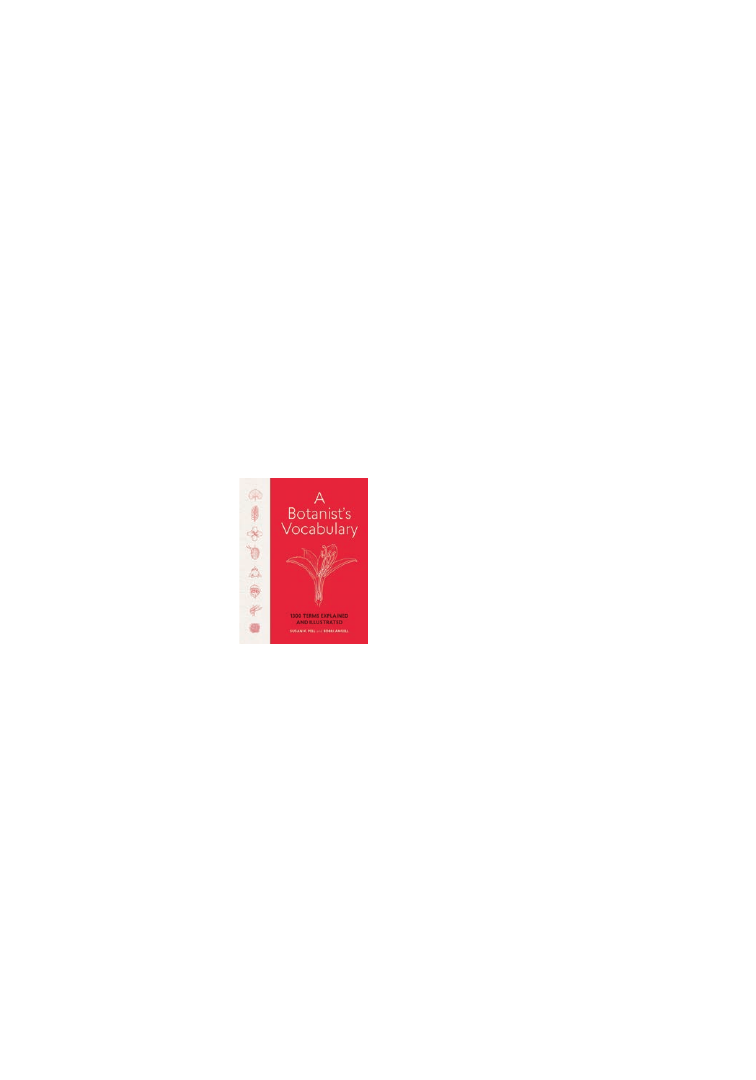
PSB 63 (1) 2017
48
Book Reviews
Bedigian, D. 2015. Systematics and evolution in
Sesamum L. (Pedaliaceae), part 1: Evidence re-
garding the origin of sesame and its closest rela-
tives. Webbia 70(1): 1–42.
Bedigian, D., D. S. Seigler, and J. R. Harlan. 1985.
Sesamin, sesamolin and the origin of sesame. Bio-
chemical Systematics and Ecology 13: 133–139.
FAOSTAT. 2014. Website http://www.fao.org/
faostat/en/#data/QC/visualize [accessed 3 Febru-
ary 2017].
Gormley, I. C., D. Bedigian, and R. G. Olmstead.
2015. Phylogeny of Pedaliaceae and Martyniace-
ae and the placement of Trapella in Plantaginace-
ae. Systematic Botany 40: 259–268.
A Botanist’s Vocabulary:
1300 Terms Explained
and Illustrated
Susan K. Pell and Bobbi
Angell
2016. ISBN-13: 978-160469-
563-2
Hardcover, US$24.95. 228
pages
Timber Press, Portland, Ore-
gon, USA
This book is written for a general audience
interested in botany and botanical terms. The
authors focus on educating naturalists and
gardeners by providing concise definitions
important for plant biologists and detailed line
drawings, which are beautiful as well. Susan
Pell is on the staff of the United States Botanic
Garden, and Bobbi Angell is a scientific
illustrator for the New York Botanic Garden
as well as for the New York Times garden
column. Together, they make a great team and
have produced this simple yet elegant book.
Pell and Angell do a great job in covering
standard items in plant morphology and
structure so that readers can identify plants
and plant parts. For instance, leaf and flower
structures are prominently featured and
illustrated (e.g., simple and compound leaves,
leaflets, palmate, pinnate). However, a broad
range of topics in botany and plant biology are
featured, but not every term has an illustration.
As a physiologist, I noted apical dominance,
chlorophyll, gravitropism, phototropism,
photoperiodism, and photosynthesis (but not,
for example, auxin and phytochrome).
Most, but not all, of the key plant groups
are covered: angiosperms, gymnosperms,
and mosses, but not ferns. However, ferns,
particularly the sensitive fern Onoclea
sensibilis, are used in many diagrams to
illustrate concepts such as the fertile frond and
sporangium. Terms important in plant ecology
also are considered, including allelopathy,
allopatric, clinal variation, and sympatric,
among others. Additional botanical fields
covered in the book include biogeography,
genetics, horticulture, soil science, taxonomy,
and tissue culture.
Professional botanists will enjoy having this
volume on their bookshelf especially given
the modest price. The book would also make
a great gift to one of their friends who enjoys
gardening and plants.
–John Z. Kiss, University of North Caroli-
na-Greensboro, Greensboro, North Carolina,
USA; jzkiss@uncg.edu
EDUCATION

PSB 63 (1) 2017
49
HISTORY
Plant: Exploring the
Botanical World
Phaidon Editors
2016. ISBN-13: 978-0-7148-
7148-6
Cloth, US$59.95. 352 pp.
Phaidon Press, London, Unit-
ed Kingdom
“Botany–the science of the
vegetable kingdom, is one of the
most attractive, most useful, and
most extensive departments of
human knowledge. It is, above every
other, the science of beauty.”—Sir
Joseph Paxton (using pseudonym
Peter Parley, 1838)
Plant: Exploring the Botanical World displays
the riches of the botanical world with assorted
natural history drawings, etchings, paintings,
watercolors, and photographs that circulated
as objects among various participants in
global networks of knowledge creation,
historically as gifts with symbolic value
exchanged in patronage relationships, and as
embodiments of the plants they represent.
It tells the story of intellectual and scientific
collaboration, debate and competition,
among naturalists for status and nations for
profit. The Phaidon editors have prepared an
assemblage set at the crossroads of botanical
art work, colonial history, and the history
of botany, united as a compelling chronicle
that provides insight into the relationship
between botany and art, while also probing
an archive of some previously little-studied
images. This anthology is as much about art
and photography as it is about plants; diverse
approaches to illustrating plant form are
revealed in art and photographs.
Juxtaposition underlies the arrangement of
this book of contrasting or complementary
images, paired on facing pages as couplets
with variable features, e.g., pp. 98–99 relate
two species of Eucalyptus geometrically for
their diagonal lines and varied angles of leaf
pairs; pp. 100–101 seem to share the color red,
contrasting rose and poppy (ca. 1760), with
sweet cherry (ca. 1561–1562); pp. 142–143
compare tree trunks in cross-section, using
a chromolithograph (ca. 1850), alongside a
light micrograph of pine stem (2011); pp.
164–165 differentiate Luffa aegyptica with
a Japanese woodblock (ca. 1900) showing a
solitary yellow flower attracting a single bee,
along with two fruits, one mature, the other
juvenile, against a copper engraving from
Venice (1640). Readers meet the storyteller’s
secret weapon—an element of surprise—
contemplating two unexpectedly related
works side by side. It may be that botanical
illustration and art photography have been
under-researched by historians of art.
Plant offers some new material and some that
is usefully repackaged.
A concise paragraph
on each page tells readers about the artist and
composition featured. Despite their number,
all of the figures are referenced in the text; they
are so skillfully interwoven that documenting
the sources of each illustration does not strike
the reader as a burden. Along with citing the
essentials, the editors are subjective, adding
analysis of the artworks.
The book is beautifully
designed, printed in Hong Kong, and rich
with delicate yet vivid color illustrations,
e.g., pp. 120–121, spotlighting the flush of a
colored Japanese woodblock print of an iris
garden (1857) against a dusky hand-tinted
copperplate engraving of a majestic black iris
from Nuremberg (1768). The volume offers a
brief 10-page chronology and a limited 7-page
index.

PSB 63 (1) 2017
50
Plant resists comprehensiveness,
acknowledging the necessarily fragmented
nature of this history; as an art book it falls
into a strange genre in contemporary botany,
hovering between several different disciplines.
Examining the work of specific artists is
rewarding and informative, an opportunity to
consider a diverse range of materials produced
over the past 500 years within a discipline
that insists on the importance of the graphic
process.
Historically, traveling naturalists worked in
concert with trained artists who drew and
painted representative specimens. These
images, in turn, were also described verbally
and often accompanied by dried plants.
Working with text, image, and dried specimen
allowed naturalists around the world to
participate in collective empiricism and
communicate with one another.
Photography promised a new means of
preserving and recording, and of quickly,
efficiently, and authoritatively rendering
views through an unimpeachable mechanical
process, seen as free from the potential of
human error. Already familiar with their
original materials, botanist-scholars could
look through a photograph to reanimate
their recollection of previously studied
materials, particularly when incorporating
contemporary renderings such as three-
dimensional visualizations of plant structures
and other modern techniques meant to serve
the needs of a scientific community.
Other books with which Plant might be
compared include Blunt’s (1955) Art of
Botanical Illustration: An Illustrated History,
which represents a benchmark in terms
of documenting botanical illustration and
provides a “comprehensive, critical and
well-illustrated survey” of how plants and
flowers have been illustrated over time
by different artists in different places for
different purposes. Rix’s (2012) Golden Age
of Botanical Art spans from 4500 B.P. through
contemporary botanical art. It explores the
origins of botanical art and the range of
botanical art produced—from florilegiums to
art produced as the result of travels to many
different places. Rix also highlights the range
of ways in which art and illustration have been
produced and a number of the people who are
key to its history.
Phaidon is recognized worldwide for
publishing fine books about art, architecture,
photography, design, performing arts,
decorative arts, fashion, film, travel, and
contemporary culture, as well as cookbooks
and children’s books, so this volume with
its focus on botanical art through history
is somewhat of a departure. Overall, Plant
successfully raises many interesting issues
in connecting the fields it represents. The
disengagement of artworks makes them
subject to meanings imposed on them by
those who use them; indeed, reframed within
this public domain, they achieve something
new, something unforeseen by their creators.
Looking at things botanically is looking for
absence as much as for presence, setting up
another tension found throughout the volume.
Plant is a singular book that should be read in
print copy, taking one’s time to meditate upon
the beauty of the photographs, and the lessons
they tell.
–Dorothea Bedigian, Research Associate, Mis-
souri Botanical Garden, St. Louis, Missouri,
USA
LITERATURE CITED
Blunt, W. 1955. The Art of Botanical Illustration:
An Illustrated History. Collins, London, United
Kingdom.
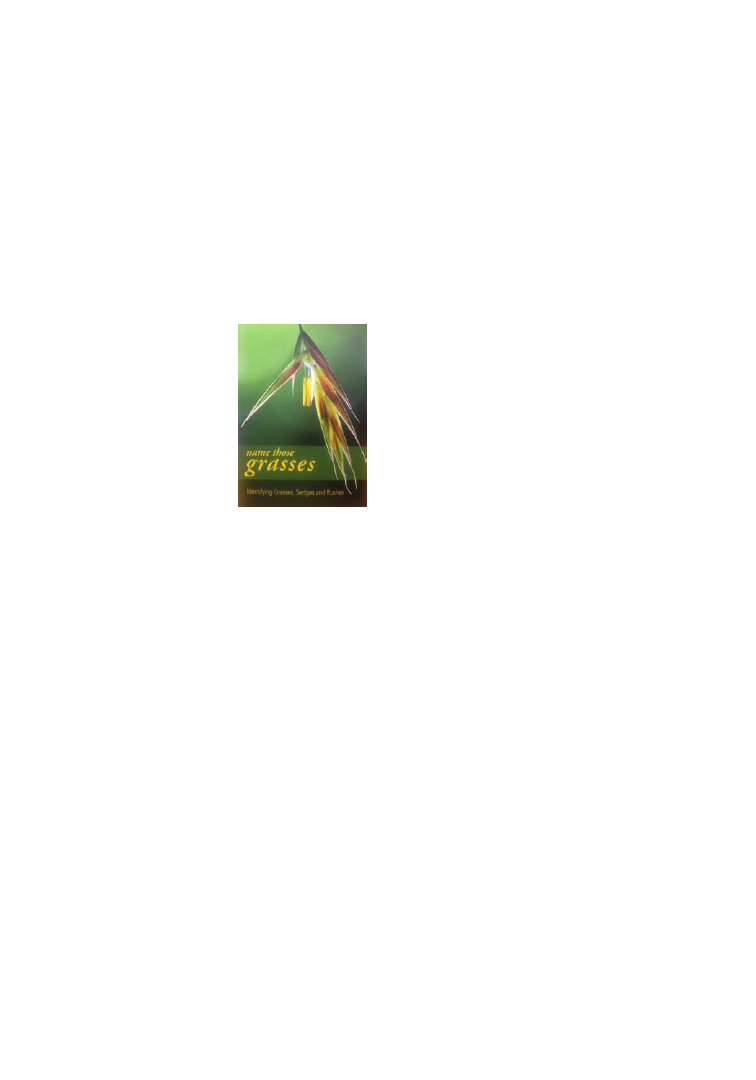
PSB 63 (1) 2017
51
Parley, P. 1838. Peter Parley’s Cyclopedia of
Botany: Including familiar descriptions of trees,
shrubs and plants. Otis, Broaders and Co., Bos-
ton, Massachusetts, USA.
Rix, M. 2012. The Golden Age of Botanical Art.
Andre Deutsch, London, United Kingdom.
SYSTEMATICS
Name Those Grasses:
Identifying Grasses,
Sedges and Rushes
Ian Clarke
2015. ISBN-13: 978-0-
9804076-4-8
Paperback, AU$48.00. 544
pp.
Royal Botanic Gardens Victo-
ria, Victoria, Australia
Name Those Grasses, by Ian Clarke, is a
beautiful and practical guide to learning to
identify grasses and grass-like plants. It is not
really a key or a flora, but instead emphasizes
that the same process of identification can
be used anywhere in the world and provides
a practical primer for identification of
these difficult families: Poaceae (grasses),
Cyperaceae (sedges), Juncaceae (rushes), and
Restionaceae (restios). The guide is intended
to be used in conjunction with standard
identification manuals for these plants in
particular parts of the world. The author is
based out of Australia, and his geographic bias
comes through in some ways, but he focuses
the book on species with wide geographic
temperate distribution (often weedy) to
broaden its usefulness.
A major emphasis of the book is the explanation
of botanical language, both general and
specific to these particular families. The
author assumes no prior knowledge and does
an excellent job in starting with the basics but
also moving efficiently into the idiosyncrasies
of the structures (and the language used to
describe them) of the families of interest. He
starts in Chapter 1 with an explanation of
botanical nomenclature and classification. He
then explains how to use the book and how it
is structured. He suggests multiple approaches
to learning how to identify the plants using
this book, depending on one’s background and
interest. He also gives a detailed explanation
of the illustrations to be very clear about how
and why they are oriented and labeled as they
are. He describes the techniques and tools
he used for the botanical illustrations, which
could be a very useful reference for other
botanical illustrators.
Chapter 2 presents an introduction to
plant structure in general, including basic
morphological terminology and illustration
of structures. It then gives an elucidation and
comparison of these basic structures in six
monocot families (Liliaceae, Orchidaceae,
Iridaceae, Poaceae, Cyperaceae, and
Juncaceae), as the author explains the reduced
and simplified floral structure of the families
that are the subject of this book. He also goes
into detail about inflorescence and vegetative
structure of the plants, again starting with
a general botanical introduction before
emphasizing the unique structures of grasses
and grass-like plants.
Chapter 3 goes into much more detail than the
first chapter about the rules of nomenclature
and classification in plants, including recent
understanding of broad-scale classification.
Chapters 4 through 7 are the heart of the book,
each emphasizing one of four major families,
giving an introduction to the family and
the structures and characteristics particular
to the family (and their variations within

PSB 63 (1) 2017
52
the family). Clear illustrations for each are
included, showing various views of flower and
inflorescence structure, often including both
intact and expanded views. These general
guides will prove very useful for learning and
understanding the structures of these tiny
flowers. A review of recent understanding
of the phylogenetic relationships within
the family follows. Then for each of the
major groups within the family, a narrative
description, sometimes (such as with the
tribes of grasses) with a table listing key
characteristics and where they are illustrated.
For each of these major groups, common
widespread and representative members
are described, with a detailed narrative
description as well as multiple careful
drawings including the whole plant, several
views of the flowers and/or inflorescences,
and (depending on what is most useful for
identification) other structures such as the leaf
blade/sheath junction, the fruit, or the culm
anatomy. Thirty-four color plates are also
included, many with multiple photographs, to
illustrate the overall plant habit as well as the
microscopic detail of flower structure of the
key groups of plants described within.
On pp. 404-407, the author provides a
condensed, one-page guide to each of the four
major families, summarizing and illustrating
their key characteristics. These pages will be
extremely helpful for those beginning their
understanding and ability to recognize and
distinguish between these four groups.
Chapter 9 is a guide to the procedures of
identifying plants in these groups. The author
describes useful equipment, gives a list of key
features for different groups, and discusses
how to use keys of various sorts (including
online keys). Then he provides keys to: (1)
the families of grasses and grass-like plants,
(2) the genera of Poaceae, (3) the genera
and sometimes species of Cyperaceae, and
(4) some species of Juncaceae. Although this
book is not meant to be a flora or field guide
per se, these keys could be useful for the most
basic level of identification of plants in these
groups; the user could then follow up with a
more thorough guide to these plants in the
user’s specific geographic area.
The author includes an extensive list of
references at the end of the book, and to the left
of each reference, gives an indicator of subject
area. This is an interesting feature and could
prove very useful for finding relevant sources
of additional information on particular topics.
A thorough glossary is also included at the
end of the book.
Generously illustrated and carefully organized,
this guide may be a welcome addition to the
library of any botanist, professional or amateur.
Despite inevitable limitations inherent in
any book that tries to usefully summarize
global diversity of grasses, sedges, and similar
plants, the author has designed a primer that
can serve as a practical introduction to these
plants that are notoriously difficult to identify.
I strongly recommend it to anyone who wants
to become adept at identification of grasses
and grass-like plants.
–Amy Boyd, Department of Biology, Warren
Wilson College, Asheville, North Carolina,
USA; aboyd@warren-wilson.edu

PSB 63 (1) 2017
53
Agaves, Yuccas, and
Their Kin: Seven Gen-
era of the Southwest
Jon L. Hawker
2016. ISBN-13: 978-089672-
939-1
Paperback, US$49.95. 456 pp.
Texas Tech University Press,
Lubbock, Texas, USA
This field guide aims to provide a thorough
treatment of seven similar genera of desert-
dwelling monocots in the American
Southwest: Agave, Dasylirion, Hechtia,
Hesperaloe, Hesperoyucca, Nolina, and Yucca.
These genera all look alike to some degree, and
indeed, six are members of the Asparagaceae.
The genus Hechtia is not related to the others
(it is a member of the Bromeliaceae) but is
included due to its superficial resemblance.
This guide was not written by a professional
taxonomist (Hawker says as much in the text)
but by an enthusiast of these groups of plants.
This brings both positives and negatives
to the work. The reader can really tell that
Hawker loves these plants and finds them
fascinating—a welcome change from other,
oftentimes dry, botanical works. The many
photos that include Hawker’s dog for scale are
cute and add another personal touch to the
book. However, the lack of keys within genera
and the use of standard measurements instead
of metric are unfortunate. There is also no
glossary, which Hawker argues is not needed
because this is not a technical guide. However,
I counter that every professional started as
an amateur and needed to learn all the terms
used to describe plants, so if an amateur yucca
enthusiast picks up this guide, how will he or
she learn those terms?
After an introduction covering what the
book aims to provide, how the maps were
made, and the region covered, the bulk of
the book is broken into seven sections. Each
section covers one of the aforementioned
genera and all species within it that occur in
California, Nevada, Utah, Colorado, Arizona,
New Mexico, and Texas. The beginning of
each section has a lengthy introduction to
each genus covering taxonomy, biogeography,
pollination, ecology, human uses, etc. These
sections are well-written and fascinating.
Again, Hawker’s love for these genera
really shines here. Each species is then
treated alphabetically with information on
geographic range, natural history, and how
it can be differentiated from similar species.
Again, technical keys would have been nice
within these sections as this format means
that the user is just “picture-matching” or
“map-matching” (because many species have
restricted ranges).
The photos are, for the most part, of high
quality, with only a few being grainy (and these
only being ones taken via a microscope). There
are photos of all aspects of the plants: habitat
shots, flowers/fruits, pollinators, leaves, and
other characters useful for identification.
Many photos are unique as well: I have never
before seen photos of the copious cuticle
being peeled off an agave leaf or of an entire
agave plant cut longitudinally.
The book is easily portable and should be in
any hiker’s backpack when making a visit to
the Southwest. Hawker does a wonderful job
of cultivating an interest in these iconic plants.
–John G. Zaborsky, Botany Department,
University of Wisconsin–Madison, Madison,
Wisconsin, USA; jzaborsky@wisc.edu

PSB 63 (1) 2017
54
Guide to the Vascular
Flora of Howell Woods,
Johnston County, North
Carolina, U.S.A.
Kelly M. Hines, Alexander
Krings, and Jon M. Stucky
2015.
ISBN-13: 978-1-889878-47-8
Paperback, US$24.00. viii +
268 pp.
Botanical Research Institute
of Texas, Fort Worth, Texas, USA
This is a large flora production for a small area
comprising only 1155 ha (2854 acres), a full-
fledged treatment of the vascular plants of just a
part of a North Carolina county. Howell Woods
is a tract of land presented to Johnston County
Community College in 1993 by Rudolph A.
Howell. As the authors note, this is the largest
property gift to any North Carolina community
college. On site is an educational center and a
garden. Howell Woods is a remarkable resource
for a community college, and the production of
this work shows the depth of commitment to
using it for education and research.
The book is well laid out and carefully edited.
After introductory material dealing with
collection methods, key construction, format,
and illustrations, there is a helpful review of
land use (“outdoor recreation, game-hunting,
sand mining, and law enforcement firearm
training”[!]). This is followed by a detailed
description of soils and a discussion of the plant
communities found within Howell Woods.
The main corpus of the book is keys. They seem
workable and carefully prepared. For example,
there is a helpful vegetative key to the species of
Utricularia
(bladderworts). There are no species
descriptions, but names and synonymy are given
as well as references to current literature. Also
included is careful documentation of collections,
either by the first author (mainly), from
herbarium specimens, or from published floras.
The authors present comparative floristic data for
local floras in the region. Except for a few color
pictures, illustrations are black and white and
taken from earlier publications, mostly Britton
and Brown (1913). An exception is the very
helpful original close-up images of perigynia and
achenes of sedges (genus Carex). Within each
group (pteridophytes, gymnosperms, monocots,
eudicots), families, genera, and species are listed
alphabetically. A species checklist and references
cited section complete the book.
I am the manager of an ecological preserve and
would love to have a flora like this to put in the
hands of my students. I imagine standing in a
plant community defined in the book on named
soils keying down sedges—what a great learning
experience. While the Guide to the Vascular
Flora of Howell Woods covers only a small part
of a single county, it will find utility in other
North Carolina counties. For a book that almost
certainly has a very limited press run, the cost is
reasonable.
–Lytton John Musselman, Department of Biolog-
ical Sciences, Old Dominion University, Norfolk,
Virginia, USA
Native Plants for Southeast Virginia, in-
cluding Hampton Roads Region
Virginia Witmer, editor
2016. No ISBN
PDF (available online) and paperback (both free; see
below for details). 69 pp.
Commonwealth of Virginia, Department of Environ-
mental Quality, Virginia Coastal Zone Management
Program, Richmond, Virginia, USA
I was pleasantly surprised to learn of this
very colorful, helpful publication from a local
newspaper column. After the article appeared,
more than a thousand readers responded,
clearly indicating public interest in native
plants. An exemplar of efforts to utilize native

PSB 63 (1) 2017
55
plants for landscape and garden planting, this
glossy booklet deserves wider recognition.
The level of presentation is ideal for the
interested public. The bulk of the book consists
of treatments of groups of plants: perennials,
groundcovers, ferns, grasses, shrubs, and trees.
Images are exceptional, the few bullet points
for each species’ image include plant habit,
light requirements, whether native or not,
habitat and wildlife use (especially birds and
butterflies), and other items of interest. Large
genera like Solidago and Viola are helpfully
presented with lists of species enhanced by
useful close-up diagnostic pictures.
Inclusion of native plants suitable for
cultivation is not exhaustive, and there are
several I would add, some are noted below.
Inexplicably, the section on ferns omits
Dryopteris ´australis, Dixie wood fern, a
native hybrid I have seen sold in Hampton
Roads garden centers and that thrives in my
Norfolk garden. Likewise, Christmas fern,
Polystichum acrostichoides, is omitted despite
being an excellent garden subject. On the
other hand, I was pleased to see in the chapter
on vines the beautiful climbing hydrangea,
Decumaria barbara, a liana that deserves
more consideration as a garden subject.
Sedges are discussed, as are rushes and
grasses, although the omission of river oats,
Chasmanthium latifolium, is surprising as
this grass is frequently used in landscaping in
Hampton Roads. In the section on shrubs, the
black huckleberry leaves labeled as Gaylussacia
baccata are likely one of the blueberries
(species of Vaccinium) instead. Speaking of
Vaccinium, I would have included deerberry,
V. stamineum, because of its masses of white,
showy flowers in the spring. The chapter on
trees includes instructive notes and images for
six oaks.
For landscapers, there are chapters describing
plants for specific habitats such as streets, dry
shade, sun shade, and especially germane for
a region surrounded by salt water—plants for
salty edges.
There is a list, albeit incomplete, of places to
see these native plants in the region and a
concise treatment of invasive plants. A helpful,
although partial, list of additional resources
of publications and websites completes the
booklet.
I was told by the editor that this is a “marketing
piece.” Perhaps. But it is more—Native Plants
for Southeast Virginia is a valuable contribution
supporting planting of our native plants that
shows how they can become part of our daily
landscape. So as a marketing tool it is a wild
success. Any serious gardener or plant lover
will want one! This is a beautiful publication
with wonderful images; it is packed with
information and carefully edited. But you may
have to wait for yours—demand is so great a
second edition is needed.
This book is available online at http://
www.deq.virginia.gov/Portals/0/DEQ/
CoastalZoneManagement/Native-Plants-for-
Southeast-Virginia-Guide.pdf. Limited print
copies are available free; contact Virginia
Coastal Zone Management, 629 East Main
Street, Richmond, VA 23219 USA.
–Lytton John Musselman, Department of
Biological Sciences, Old Dominion University,
Norfolk, Virginia, USA
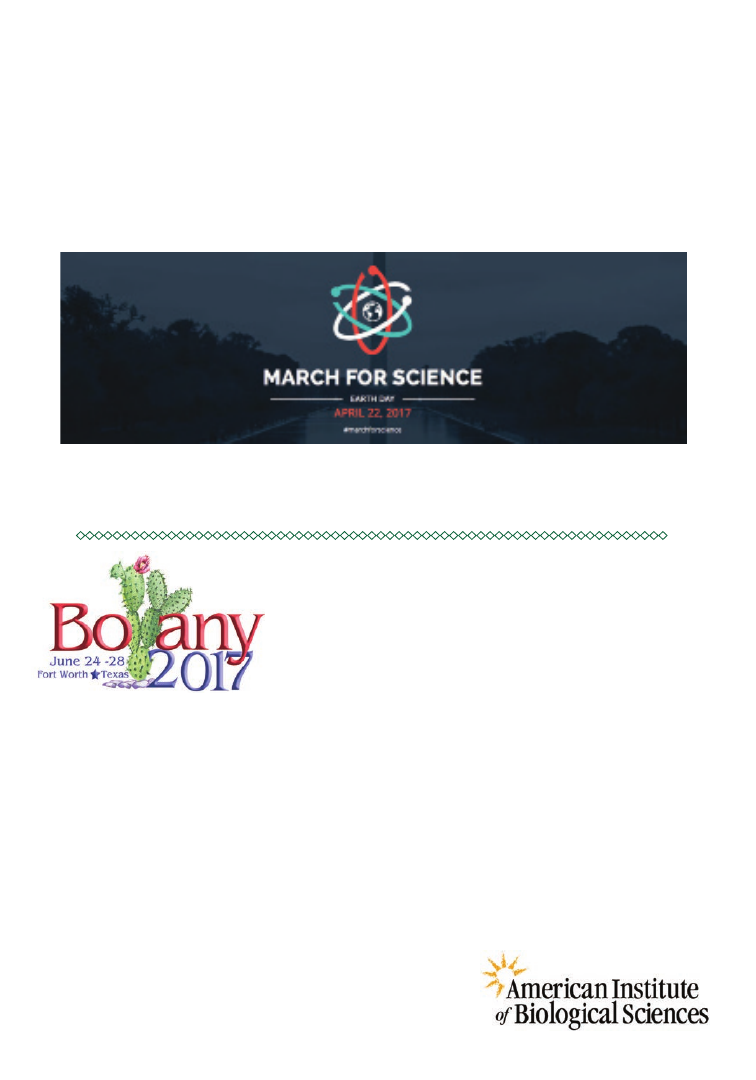
PSB 63 (1) 2017
56
Botany is #notaquietscience:
Make sure your voice is heard!
The Botanical Society of America has partnered with March for Science for their glob-
al event taking place April 22, 2017. The march is intended for scientists of all fields
to engage with political leaders and policy makers to enact evidence-based policies in
the public interest. Check out www.marchforscience.com for more information on a
march near you.
AIBS Communicating Science to Decision-makers
This three-hour session provides scientists with practical information, resources, and tools
to more effectively communicate science to decision-makers. The program will explore
different techniques for educating and engaging the public, policy/lawmaker, and the news
media. In addition to learning about how different audiences receive information, we will
learn how to frame and deliver a message to increase the likelihood of it being received by
the target audience. We will also consider how current political and policy debates inform
and influence how scientists should communicate with different audiences. This session
includes some small-group, interactive exercises.
Limited to 30 participants - $30.00/person
Presented by: Robert Gropp
Sign up: www.botanyconference.org
Coming to Botany 2017?
Sign up for this timely workshop
Sunday Morning, June 24 9:00 am - 12:00 pm
March for Science

Plant Science Bulletin
Featured Image
The Botanical Society of
America is a membership soci-
ety whose mission is to: pro-
mote botany, the field of basic
science dealing with the study
& inquiry into the form, func-
tion, development, diversity,
reproduction, evolution, & uses
of plants & their interactions
within the biosphere.
ISSN 0032-0919
Published quarterly by
Botanical Society of America, Inc.
4475 Castleman Avenue
St. Louis, MO 63166-0299
Periodicals postage is paid at
St. Louis, MO & additional
mailing offices.
POSTMASTER:
Send address changes to:
Botanical Society of America
Business Office
P.O. Box 299
St. Louis, MO 63166-0299
bsa-manager@botany.org
The yearly subscription rate
of $15 is included
in the membership
A d d r e s s E d i t o r i a l M a t t e r s (o n l y ) t o :
Mackenzie Taylor, Editor
Department of Biology
Creighton University
2500 California Plaza
Omaha, NE 68178
Phone 402-280-2157
psb@botany.org
Plant Science Bulletin
Spring 2017 Volume 63 Number 1
In 2017, more and more scientists—including the BSA
members shown above—are becoming more politically and
socially active. From the #actuallivingscientist social media
campaign to the March for Science planned throughout the
world in April, botanists and fellow scientists are finding the
need to make sure their voices are heard and concerns are
addressed in relation to the importance of their research as
well as its continued funding.
Thanks to the following for allowing us to use their pho-
tos here: Matthew Bond, Margaret Frank, Eve Emshwiller,
Jeffrey Ross-Ibarra, Heather Schneider, Stacey Smith, Kevin
Weitemier, Irene Liao, Ashley Morris, and Tanya Cheeke.
#actuallivingscientist
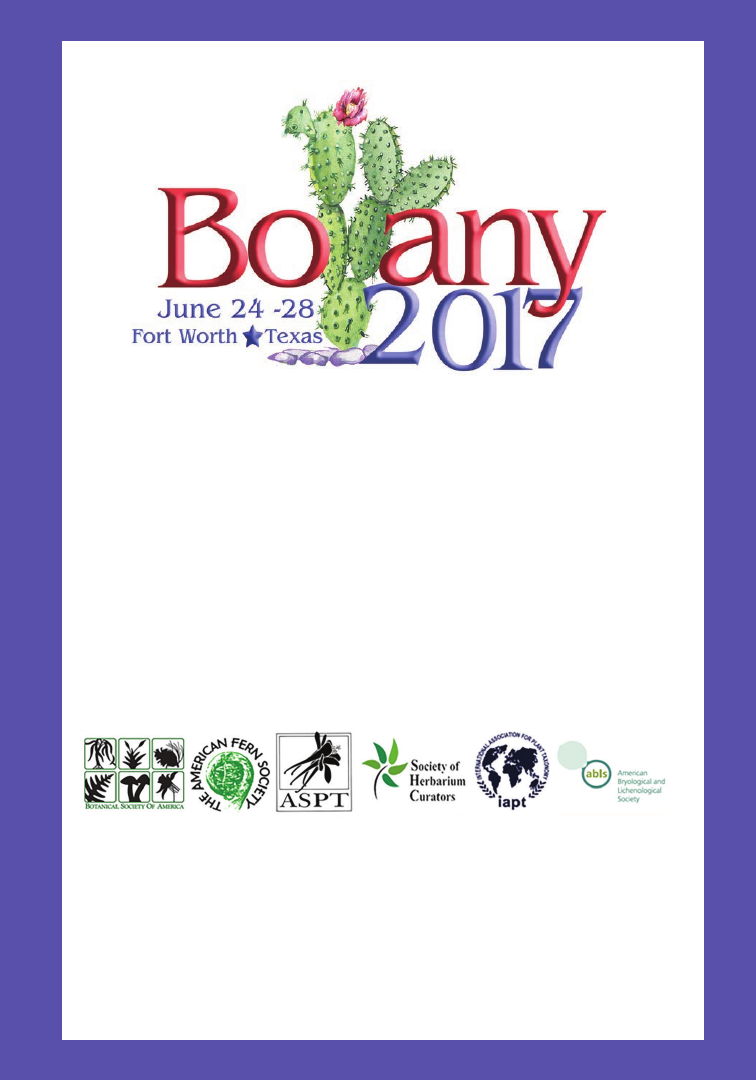
Be sure and view the video
at:botany.org
Fort Worth Omni
✰
Fort Worth,Texas
Join these Societies for the
Premier Scientific Conference of Next Summer!
www.botanyconference.org
Register Now!